Last Updated: April 2023

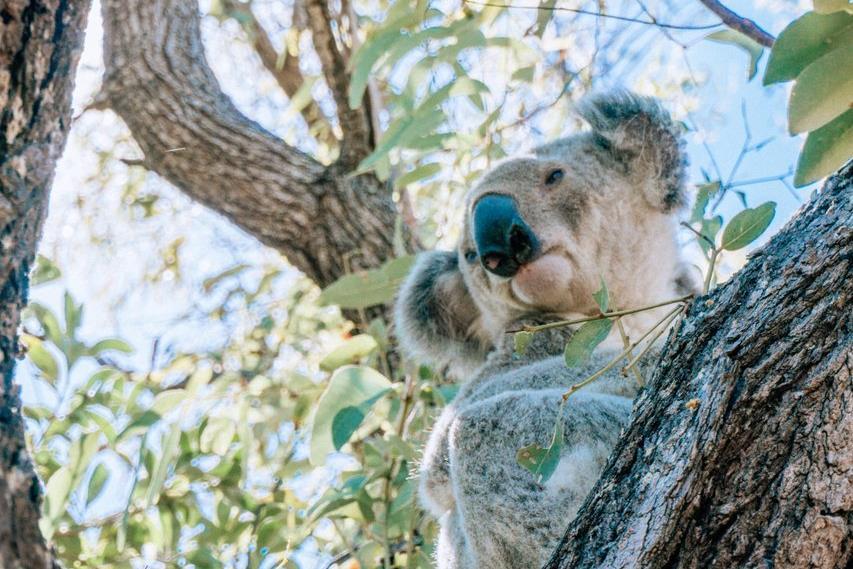
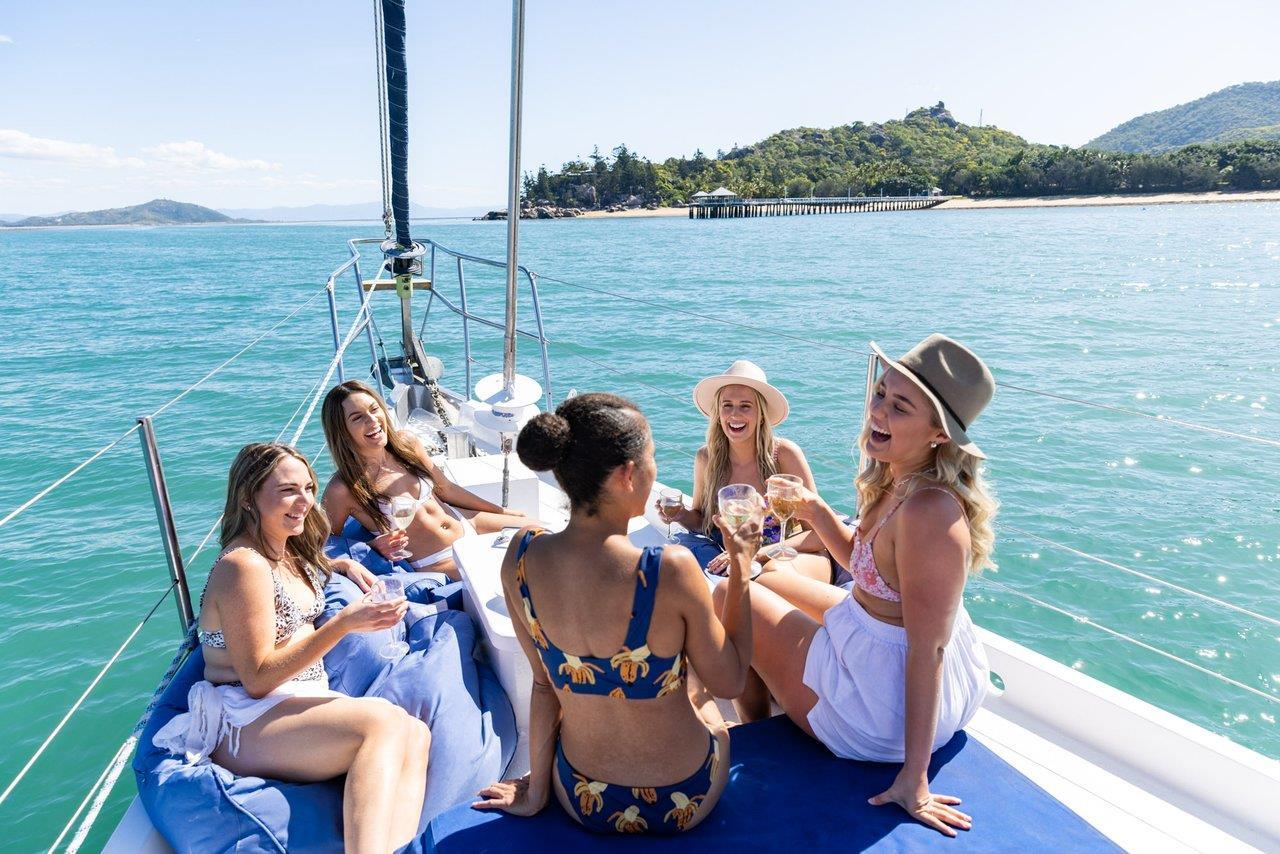

This report, the Magnetic Island (Yunbenun) Tourism Masterplan was prepared by TRC Tourism for Townsville Enterprise Ltd.
ACKNOWLEDGEMENT OF COUNTRY
We acknowledge the Indigenous peoples of the lands, waters and communities we work together with. We pay our respects to their cultures and to their Elders – past, present and emerging.
DISCLAIMER
Any representation, statement, opinion or advice expressed or implied in this document is made in good faith but on the basis that TRC Tourism Pty. Ltd., directors, employees and associated entities are not liable for any damage or loss whatsoever which has occurred or may occur in relation to taking or not taking action in respect of any representation, statement or advice referred to in this document.

FUTURE UPDATES OR AMENDMENTS
Future updates, amendments or removals from this Tourism Masterplan will be conducted by the Magnetic Island Tourism Masterplan Steering Committee (to be replaced by the Magnetic Island Tourism Alliance upon establishment)
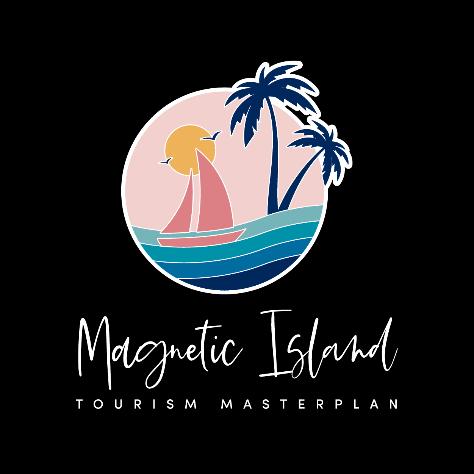

LAST UPDATED: April 2023
IMAGE CREDIT
Townsville Enterprise Ltd
©Copyright TRC Tourism Pty Ltd

Welcome
Magnetic Island (Yunbenun) is a thriving community uniquely positioned within the World Heritage Listed Great Barrier Reef and provides a compelling proposition for visitors of today and tomorrow. In recent years, the island has experienced unprecedented visitation, welcoming around 290,000 visitors and supporting approximately 25% of the region’s tourism jobs.
This Tourism Masterplan has been co-designed with community, industry and Government. Extensive consultation involved online forums, face to face workshops, meetings and newsletters. Feedback through a submission process has also been sourced to create this final Tourism Masterplan. We heard a lot of different perspectives about the challenges and opportunities for the Island. There was also overwhelming acknowledgement that we must do more to protect island’s natural and cultural values. We discovered that industry, community and government stakeholders are remarkably aligned in their aspirations for Magnetic Island, and it is important that this plan reflects this collective vision.
The Magnetic Island (Yunbenun) Tourism Masterplan is a blueprint designed to ensure visitor growth is managed to protect the natural environment and deliver a world-class, best in Australia experience that aligns to the values and vision of the community, increase the
economic return from tourism and attract private investment to the island.
The draft plan includes tourism growth forecasts for Magnetic Island. Given the strong appeal and demand for Magnetic Island, history demonstrates that growth in tourism is likely to continue even without implementation of this plan. The draft plan aims to direct this growth in a sustainable way. We want to drive growth in the visitor economy by focussing on the value of the visitor economy via increases in expenditure rather than high volumes of visitors and to achieve this we need to attract the right type of investment that fosters a balance of economic, social and environmental values.
Whilst the plan is a framework and path forward for the future visitor economy on Magnetic Island, each of the actions and projects identified in the draft masterplan will be required to undergo the appropriate approval processes including further community consultation.
We thank everyone who has been involved in the process to develop this draft document. With a strong vision, a united voice and a clear plan forward, now is our chance to drive greater value and return from tourism on Magnetic Island for the betterment of the community and the industry, and to enhance the experience for the thousands of visitors who are welcomed to our wonderful island home.
Magnetic Island (Yunbenun) Tourism Masterplan | 2023 i
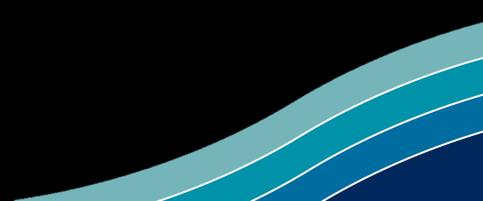
Magnetic Island (Yunbenun) Tourism Masterplan Contents Your Invitation to Comment ......................................................................Error! Bookmark not defined. Contents............................................................................................................................................ ii Executive Summary 1 PART A – Background and Context...................................................................................................... 7 1. Introduction 8 2. Our Competitive Advantage..................................................................................................... 11 3. Strategic Alignment 16 4. Key Visitor Markets................................................................................................................. 22 5. Visitor Experience and Product Profile...................................................................................... 25 6. Catalysts for Change ............................................................................................................... 31 PART B – Magnetic Island (Yunbenun) Tourism Masterplan – Priorities and Actions ........................... 34 7. A New Framework for Tourism on Magnetic Island ................................................................... 36 8. Tourism Specific Priority Projects............................................................................................. 41 9. Tourism Investment Enablers .................................................................................................. 47 10. Growth Projections................................................................................................................. 51 Appendix 1 – Townsville North Queensland Regional Snapshot ......................................................... 55 Appendix 2 – Infrastructure.............................................................................................................. 58 Appendix 3 – Magnetic Island Visitors and New Attractions – Economic modelling............................. 60 Appendix 4 – Consultation Summary ................................................................................................ 65
ACRONYMS
DTIS Department of Tourism, Innovation and Sport (Queensland)
DTMR Department of Transport and Main Roads (Queensland)
GBRMPA Great Barrier Reef Marine Park Authority
GBRWHA Great Barrier Reef World Heritage Area
GRP Gross Regional Product
HVT High Value Travellers
IVS International Visitor Survey
LGA Local Government Area
MICDA Magnetic Island Community Development Association
MINCA Magnetic Island Nature Care Association
MIRRA Magnetic Island Residents and Ratepayers Association
QLD Queensland
QPWS Queensland Parks and Wildlife Service
RTO Regional Tourism Organisation
TCC Townsville City Council
TEL Townsville Enterprise Limited

TEQ Tourism Events Queensland
TMI Tourism Magnetic Island
TRA Tourism Research Australia
VFR Visiting Friends and Relatives
YAG Yunbenun Advisory Group
GLOSSARY OF TERMS
Domestic Day Trip
Those who travel for a round trip distance of at least 50 kilometres, are away from home for at least 4 hours, and who do not spend a night away from home as part of their travel.
Domestic Overnight Visitors
People aged 15 years and over who undertake an overnight trip of one night or more and at least 40 kilometres away from home are referred to as overnight visitors.
International Visitor
A person is defined as an international visitor to Australia if they are currently a resident overseas, have been in Australia or less than one year and are aged 15 years or over.
Gross Regional Product
A monetary measure of the market value of all final goods and services produced in a region in a period of time (quarterly or yearly).
Wulgurukaba Wulgurukaba people are the Traditional Owners of Yunbenun (Magnetic Island)
Yunbenun Yunbenun is the Wulgurukaba name for Magnetic Island
Regenerative Tourism Regenerative tourism is where visitors have a positive impact on their holiday destination, meaning that they leave it in a better condition than how they found it. A concept that goes beyond "not damaging" the environment and that aims to actively revitalise and regenerate it, resulting in a positive cycle of impacts (local communities, environment and economies).
Magnetic Island (Yunbenun) Tourism Masterplan

Executive Summary
Magnetic Island, traditionally known as Yunbenun, sits at the core of North Queensland’s tourism offering and is the destination icon of the Townsville region.
Home to the Wulgurukaba people, Magnetic Island (the island) is part of the Great Barrier Reef World Heritage Area (GBRWHA) and over two-thirds of the island is protected as national park. It is one of only a few islands within the GBRWHA that is home to a permanent community of 2,300 people who bring social character, vibrancy, and culture to the island. The community’s deep commitment to protecting the uniqueness and authenticity of the island and their desire to share this with travellers gives the island a distinctive character when compared to other Queensland islands. Importantly, it plays a key role in showcasing the Great Barrier Reef World Heritage Area to the world. The Queensland Government has a long-term commitment to grow the state’s $23 billion tourism industry and secure Queensland’s position as a worldleading tourism destination. Other island destinations are making plans and investing to improve their competitiveness to support this ambition. Magnetic Island can also play a significant part in growing the State’s visitor economy.
To sustain growth, a thriving community, and a competitive visitor economy, Magnetic Island’s tourism offering will need to be distinctive to ensure it stands out amongst other island destinations in Queensland and further afield. This will require strengthening the profile of the island to new markets, investing in visitor infrastructure, as well as products and experiences that showcase the natural and cultural attributes of the island and the Great Barrier Reef.
The Magnetic Island (Yunbenun) Tourism Masterplan is a blueprint for:
• investment in infrastructure across the island that will contribute to a thriving community
• ensuring growth of the visitor economy is appropriately managed to conserve the significant landscape, environmental and cultural values of Magnetic Island and the GBRWHA
• delivering ‘best of Australia’ tourism experiences by matching the island’s position in GBRWHA and its natural beauty with a mix of immersive experiences that improve the appeal of the destination
• increasing the economic return from tourism through increasing the value of tourism expenditure
• attracting private investment to Magnetic Island.
The plan proposes a list of initiatives (and related ‘enablers’) for sustainable tourism on Magnetic Island. It presents an ambitious and shared vision, clear direction about the type of travellers and the experiences to be offered and the priority projects and actions required to achieve the stated objectives.
It is designed to be a shared resource for industry, government, stakeholders, and funding agencies to guide management and investment on Magnetic Island. Consultation was an integral component of the Masterplan’s development and we heard from residents, Traditional Owners, industry, community organisations, government stakeholders and investors. We heard about the island’s attributes most valued by residents and visitors; challenges and opportunities what to protect or mitigate, what to preserve or grow, and where the gap can be closed or bridged. Stakeholder and community input assisted in identifying and determining the longterm vision for the island and the priorities required to achieve it. The draft plan reflects the views expressed by industry, the community and other stakeholders during consultation that occurred between March 2022 and February 2023
Where we are now
As a destination, the island’s primary product strengths lie in its nature-based and outdoor experiences associated with the Great Barrier Reef Word Heritage Area and Marine Parks, Magnetic Island National Park, Forts Walk and Forts Junction, walking trail network, significant wildlife, attractive bays and beaches. Many tourism attractions and products have been developed to capitalise on these unique natural settings and provide a high-quality visitor experience. These include bush walking, natural and cultural interpretive displays, birdwatching, boat trips, snorkelling trails and tours, water sports, golf, diving expeditions, jet skiing and fishing. The island offers a range of accommodation for visitors, predominantly ‘upper midscale’ and quality serviced accommodation that cater to the family markets. The island’s proximity to Townsville and connectivity with air, ferry and road infrastructure connecting to Queensland’s population centres provides a significant competitive advantage for the 290,000 visitors it receives There are an estimated 211 businesses operating on Magnetic Island including accommodation, restaurants, various shops, transport operators and a golf course 1
Magnetic Island (Yunbenun) Tourism Masterplan - 2023 1
1 Magnetic Island Economic Assessment Final AEC 2019
Visitors can experience the natural features of the island with all the benefits of a permanent population including good food and beverage offerings, retail and convenient transport options.
The visitor economy on the island generates $380.2 million in economic output for businesses within North Queensland (including $170.5 million in direct impacts) creating 1,746 jobs. The main employment on the island is in accommodation, food services and retail.2 The importance of the tourism industry to the local economy is reflected through these sectors as well as retail trade. There are several drivers that will generate additional interest in the region over the next decade including the implementation of the Townsville City Plan, the refurbishment of Reef HQ Aquarium and the Brisbane Olympic Games.
The nature of tourism continues to present new opportunities and challenges for Magnetic Island’s visitor economy. These include changing consumer expectations, climate adaptation and resilience, sustainable tourism practices, cultural awareness and inclusivity, and the importance of community sentiment about tourism.
Tourism businesses are experiencing pressures including insurance, labour shortages and rising costs which is impacting on the type and level of investment on the island. The costs associated with providing public infrastructure to service the needs of residents and visitors are increasing and it is unreasonable to expect that ratepayers will have to bear the full cost of maintaining infrastructure that is also used by visitors. The availability of housing and parking is an ongoing concern for residents.
Where we want to be
In the face of this changing context, we need to lean in on our competitive advantage and strengthen our approach to destination development. As such our industry, community and government stakeholders have come together to develop a shared vision.
We want Magnetic Island to be a world leading sustainable island destination inspiring land and reef stewardship that enhances the quality of life of our community and strengthens the cultural identity of our island home.
We believe that Magnetic Island has the potential to be a global leader in regenerative tourism by integrating compelling, world class visitor experiences with care for land and seascapes, creating vibrant communities, strengthening livelihoods, and ensuring sustainable environmental management. We want to drive growth in the visitor economy by focussing on the value of the
visitor economy via increases in visitor expenditure (yield) rather than high volumes of visitors
To achieve this, we need to attract the right type of investment that fosters the conditions for a thriving visitor economy and develop tourism in a manner that balances economic, social and environmental values. We need to strengthen support for the industry by aligning the collective efforts of the various organisations responsible.
Our Approach
The following themes have been identified for the development of tourism on Magnetic Island. While each theme is important in and of itself, the strength of the Magnetic Island Tourism Masterplan and the success by which it is measured will stem from the need to ensure they are interconnected and pursued in balance. The projects and actions under each theme below are designed to enhance the island's competitive strengths and facilitate development opportunities for public infrastructure to support tourism growth. They have been identified through consultation with government, industry and community stakeholders.
Global Positioning, Branding and Marketing
We will create a new tourism brand based on the island’s competitive advantages that leverages Magnetic Island’s location within the GBRWHA and positions it as a high value destination and leader in regenerative tourism.
Regenerative Leadership
We will develop products and experiences that enable connection with island and reef regeneration in a meaningful and authentic way. Key actions include the design and co-ordination of environmental stewardship programs in partnership with the marine researchers, tourism operators, Wulgurukaba traditional owners and Magnetic Island community groups. We will develop a ‘Magnetic Island Future” Destination Stewardship Program to communicate to visitors how to make their visit more sustainable and help protect the island’s values.
Outstanding Products and Experiences
We will work with investors to enhance existing and develop new tourism attractions to support exceptional high value experiences. Examples include the Magnetic Island Koala Hospital, Magnetic Island Resilient Reef Centre of Excellence, Ocean Sentinels Snorkel Trail, quality accommodation and new events and festivals aligned with our new positioning.
Magnetic Island (Yunbenun) Tourism Masterplan - 2023 2
2 Ibid
World Class Infrastructure and Amenity
We will invest in major public infrastructure projects and a tourism-led place/precinct building program with design standards to ensure infrastructure developments are in keeping with the desired World Heritage Values and experience and fit into the surrounding landscape to support economic growth and accommodate projected increases in visitation.
Key actions include improving the Magnetic Island Terminal Arrival Experience, revitalising Picnic Bay and Horseshoe Bay as visitor hubs, develop and market the Four Village Land and Sea Trail, design and implement infrastructure guidelines and whole of island interpretation and wayfinding. We will work with our partners to improve digital and mobile infrastructure improvement and a sustainable transport network.
Leadership, Partnership and Coordination
We will strengthen our leadership, develop partnerships and industry capacity to support a unified approach to tourism management. Key actions include establishment of a new tourism partnership between community, government and industry and to be known as the Magnetic Island Tourism Alliance, a tourism research program to inform our decision making, investigation of potential options for a visitor levy, investment attraction mechanisms and industry development.
The impact of additional investment on visitor demand
Visitor demand modelling indicates that investment in new products and experiences as outlined in the Magnetic Island Tourism Masterplan will likely generate an additional 98,259 visitors and 295,000 visitor nights over the ten years from 2022. If we can achieve a trajectory following this growth scenario, overnight visitor expenditure from both domestic and international visitors will generate an estimated $50 million over the same period.
The modelling indicates that 236 additional rooms would be required to service the visitor growth under this scenario. These rooms may take the form of upgraded facilities, expansions on new properties or new developments
By implementing this plan, government, industry and the community are embarking on a journey with the shared ambition of creating sustainable and long-term value for Magnetic Island and its residents. Its intent is also to create lifelong memories for tomorrow’s travellers who value the special nature of the island and support its stewardship.

Magnetic Island (Yunbenun) Tourism Masterplan - 2023 3
OUR VISION
A world leading sustainable destination inspiring land and reef stewardship that enhances the quality of life of our community and strengthens the cultural identity of our island home.
OUR OBJECTIVES
Community
Enhance the quality of life for residents and increase connection with Traditional Owners, by working with the community to plan the most appropriate types of tourism that support their wellbeing and prosperity.
Visitors
Deliver exceptional experiences tailored to attract and satisfy the high value traveller, maximising satisfaction resulting in increased length of stay, expenditure and dispersal across the year.
Industry
Support competitive and sustainable tourism businesses that will attract and satisfy target markets and maximise social, economic and cultural benefits to the community.
Environment
Implement sustainable tourism practices, in partnership with national, regional and local stakeholders, implementing programs designed to protect the values of Magnetic Island and the Great Barrier Reef World Heritage Area.
OUR PRIORITIES
Global Positioning Regenerative Leadership
Outstanding Products and Experiences
World Class Infrastructure Leadership, Partnership and Coordination
WE WILL MEASURE OUR SUCCESS BY
Our ability to increase visitor spend and visitation across the whole year.
KPI – Increase in visitor yield ($) and increase in the number of visitors in the off-peak periods
Our ability to transform the experiences we offer through the investment we attract.
KPI - Number of new or enhanced brand aligned products and experiences and value of investment ($M).
A community that benefits from tourism.
KPI – Annual survey of residents to determine value and sentiment about tourism.
A thriving visitor economy that is resilient and sustainable.
KPI – Sector output ($M), and total employment.
Maintain and preserve the WHVs to avoid degradation
















KPI – delivery of projects which support decarbonisation, regeneration or promote positive visitor behaviour.

Magnetic Island (Yunbenun) Tourism Masterplan - 2023 4
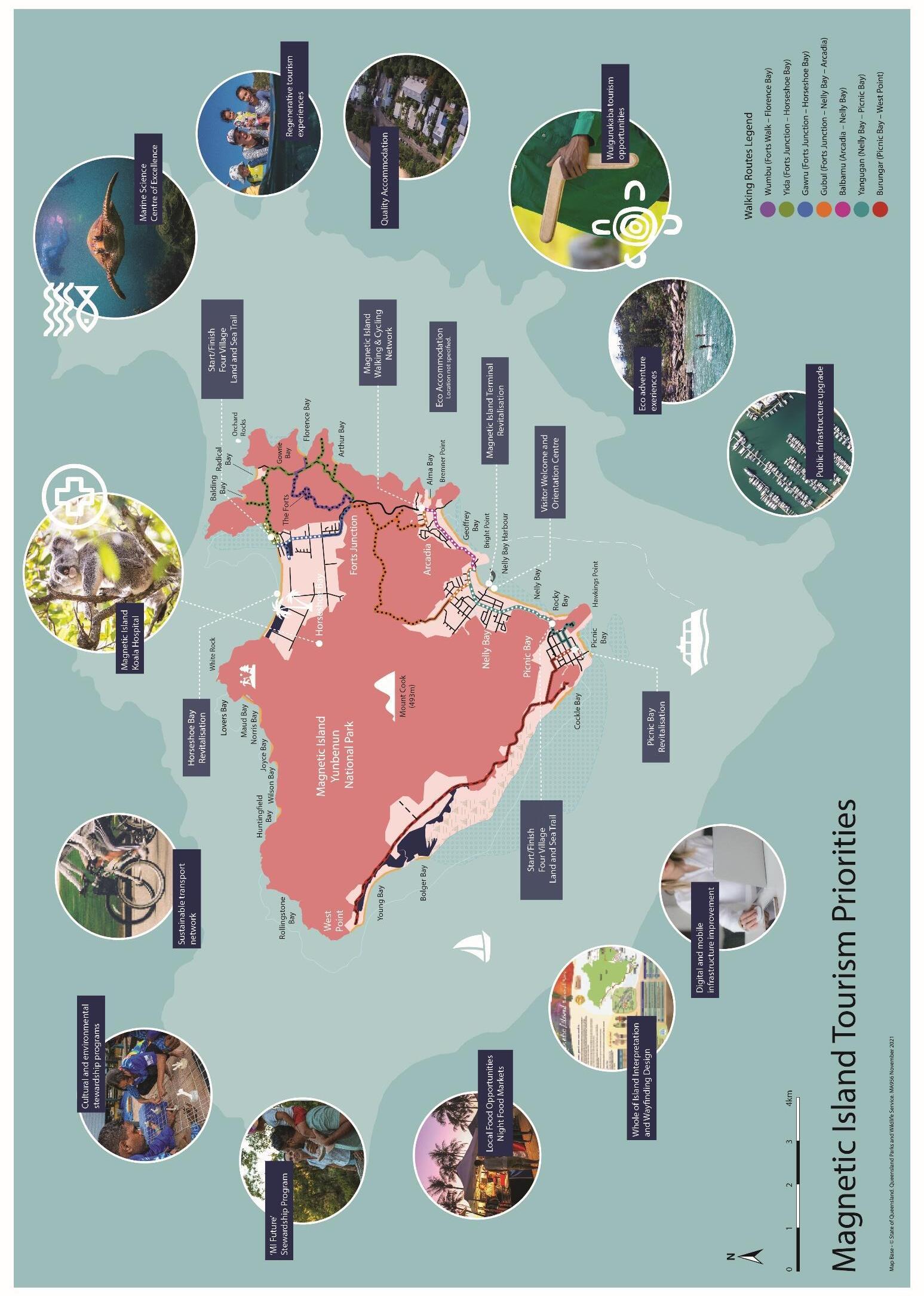
Magnetic Island (Yunbenun) Tourism Masterplan - 2023 5
Figure 1. Magnetic Island Tourism Masterplan – Tourism Priorities
Our Vision

To be a world leading sustainable island destination inspiring land and reef stewardship that enhances the quality of life of our community and strengthens the cultural identity of our island home.

PART A –Background and Context

1. Introduction
Home to the Wulgurukaba people, Magnetic Island (Yunbenun) is part of the Great Barrier Reef World Heritage Area (GBRWHA). Although it is only a relatively small part of the 35-millionhectare GBRWHA, the island has features and values that are found nowhere else within it.3 Over two-thirds of the island is also protected as national park.
Twenty minutes from Townsville, it is one of only a few islands within the GBRWHA that supports a permanent community. Around 2,300 people live on the island and collectively they bring social character, vibrancy and culture to the destination.
The community has a deep commitment to protecting the uniqueness and authenticity of the island and a desire to share this with travellers
To sustain growth, a thriving community and a competitive visitor economy, Magnetic Island’s tourism offering will need to be distinctive to ensure it stands out amongst other island destinations.
The Queensland Government has a long-term commitment to grow the state’s $23 billion tourism industry and secure Queensland’s position as a world-leading tourism destination.
On 3 November 2022, the 'Towards Tourism 2032' long term tourism industry strategy was released as a collective partnership between industry and government to guide growth and success of Queensland’s visitor economy. A number of significant key actions include delivering recently announced tourism grant funding programs; developing new/refreshed Destination Management Plans; developing a clear tourism industry pathway to net zero emissions; protected area investment to support nature-based tourism
and developing an Indigenous Tourism Development Roadmap. Magnetic Island is well positioned to align with and support the delivery of the vision and goals of Towards Tourism 2032. Co-designed with industry, community and government partners, the Magnetic Island Tourism Masterplan (this plan) supports the Queensland Government’s vision to be Australia’s destination of choice for domestic and global visitors seeking the world’s best experiences.
1.1 The Opportunity
Magnetic Island can become a global leader in regenerative tourism in the GBRWHA, integrating exceptional experiences with care for land and seascapes, strengthening traditional owner opportunities, ensuring sustainable environmental management, and pushing beyond its current positioning as ‘another Queensland Island destination’.
The opportunity for Magnetic Island is to leverage Townsville’s emerging reputation as a global centre of excellence for marine science, combine this knowledge with traditional owners, the resources and experience of the tourism industry and the local community to create world class immersive and powerful experiences that enrich and connect visitors to Magnetic Island
This will not be easy. It will require compelling products and experiences that showcase the natural and cultural attributes of the island and the broader GBRWHA. It will need a clear plan to ensure that investments are strategic and directed to the right priorities, improved co-ordination, and shared responsibility
Magnetic Island (Yunbenun) Tourism Masterplan - 2023 8
Magnetic Island plays a critical role in driving economic growth to the Townsville region through tourism, providing amenities that benefit locals as well as visitors.
3 The boundary of the World Heritage Area commences at the northernmost extremity of Cape York Peninsula, and continues south, at low water, to just north of Bundaberg, and then seaward
to the extent of the Great Barrier Reef Marine Park. All areas within this boundary, including Magnetic Island and all other islands are within the Great Barrier Reef World Heritage Area.
1.2 The Magnetic Island (Yunbenun) Tourism Masterplan

The Magnetic Island (Yunbenun) Tourism Masterplan provides a blueprint for:
• investment in infrastructure across the island that will contribute to a thriving island community
• ensuring growth of the visitor economy is appropriately managed to conserve the significant landscape, environmental and cultural values of Magnetic Island and the GBRWHA
• delivering ‘best of Australia’ tourism experiences by matching the island’s position in GBRWHA and its natural beauty with a mix of immersive experiences that improve the appeal of the destination
• increasing the economic return from tourism through increased length of stay and expenditure; and
• attracting public private investment to Magnetic Island.
The development of this plan was funded by the Queensland Government and managed by Townsville Enterprise Limited (TEL) with input and guidance by a Steering Committee. The Steering Committee included representatives from the Department of Tourism, Innovation and Sport, Queensland Parks and Wildlife Service, Wulgurukaba Aboriginal Corporation, Townsville City Council, Magnetic Island Community Development Association and Magnetic Island Residents and Ratepayers Association, and the Magnetic Island Nature Care Association.
Consultation with residents, Traditional Owners, industry, community organisations, government stakeholders and investors occurred between March 2022 and February 2023 The consultation highlighted the island’s attributes valued by residents and visitors; challenges and opportunities what to protect or mitigate, what to preserve or grow, and where the gap can be closed or bridged. The actions were then grouped, and overarching development themes were developed. Several priority projects identified in the consultation process were assessed and included in this plan. By implementing this plan, government, industry and the community are embarking on a journey with the shared ambition of creating sustainable and long-term value for Magnetic Island and its residents. Its intent is also to create lifelong memories for tomorrow’s travellers who value the special nature of the island and support its stewardship.
Magnetic Island (Yunbenun) Tourism Masterplan - 2023
What is important to us
Our priorities for tourism
What we need
Our vision for Magnetic Island Environment and Community and Business

Visitor Experience Quality
Tourism Development Themes





Global Positioning, Branding and Marketing World Class Infrastructure Regenerative Leadership Outstanding Products and Experiences
Tourism Enablers
Shared Investment and Responsibility Government, Industry, Investors and our Community
Figure 2. Magnetic Island (Yunbenun) Tourism Masterplan Framework
2. Our Competitive Advantage
This section presents the attributes that make Magnetic Island a desirable and competitive visitor destination.
2.1 Overview
Magnetic Island’s competitive advantages lies in the unique combination of its natural amenity with its beaches, reef, national park and its resident population base. Visitors can experience the natural environmental features of the island with all the benefits of a permanent population. Other attributes include:
• the island’s proximity to Townsville
• accessibility and connectivity with air, ferry and road infrastructure connecting the destination to Queensland population centres
• a capable workforce based in the region that can service the tourism industry
• village hubs that are compact and accessible
• walking and cycling trails that link parts of the island
• a variety of product and experiences including nature-based and outdoor, retail and food and beverage; sport and recreation activities and events.
Although not each product category is recognised as a primary strength, collectively they attract nearly 300,000 visitors each year, including families and adult couples that generate significant economic benefits.
2.2 Natural and Cultural Values
Magnetic Island is located within the dry tropics of Queensland, with a tropical and humid climate. The island has over 23 bays and beaches boasting serenity and natural beauty
The island receives less rainfall than the Wet Tropics to the north and the Whitsunday Islands to the south, which makes the island quite dry with a dense shrub type vegetation. It has a dry season with minimal rain and days with long hours of sun. Average temperatures range between 25oC and 32oC throughout the year.
Over two thirds of the island is protected for conservation as part of the Magnetic Island National Park and it is also part of the Great Barrier Reef World Heritage Area (GBRWHA). Notably, the island boasts the closest access point to the Great Barrier Reef comprising of a unique ecosystem of coral reefs that
support high marine biodiversity including various species of fishes, invertebrates, sea snakes, dolphins, turtles and dugong. The surrounding reefs and oceans fall within the Great Barrier Reef Coast Marine Park and the Great Barrier Reef Marine Park.
The island is also a haven for wildlife and is home to the largest population of wild koalas in Northern Australia. Much of the landscape is covered by eucalypt and acacia woodlands, supporting a range of plant species including kapok on the hillslopes, melaleucas in the wetlands, and spinifex in open areas. Hoop pines jut out from much of the granite boulder coastline, where rock wallabies may be seen at dawn and dusk.
The seascape, flora and fauna of the island, and marine life in the surrounding waters, are protected for the enjoyment of the island community, visitors and the conservation of nature. This is a compelling and distinct feature of the island as a destination and protection of the island’s natural values is central to the future of tourism on Magnetic Island
The island's interesting past, in addition to Wulgurukaba peoples’ past use of country, has included hoop pine logging, a quarantine station for the port of Townsville, early tourism in the 19th century, pineapple farming and coastal defences during World War II. Magnetic Island's WWII forts are listed on the Queensland Heritage Register and are among the best examples of such fortifications on Queensland's east coast. The Forts Walk is the most popular visitor node on the island and allows visitors to view and appreciate most of the natural, scenic and cultural World Heritage values of the protected area and see koalas in the wild
Magnetic Island (Yunbenun) Tourism Masterplan - 2023 11
2.3 Our Community
Importantly, the island is one of only a few islands within the GBRWHA that supports a residential population of approximately 2,300 people. The Wulgurukaba people are the traditional owners and they have an important and ongoing connection to the island’s land and sea country.
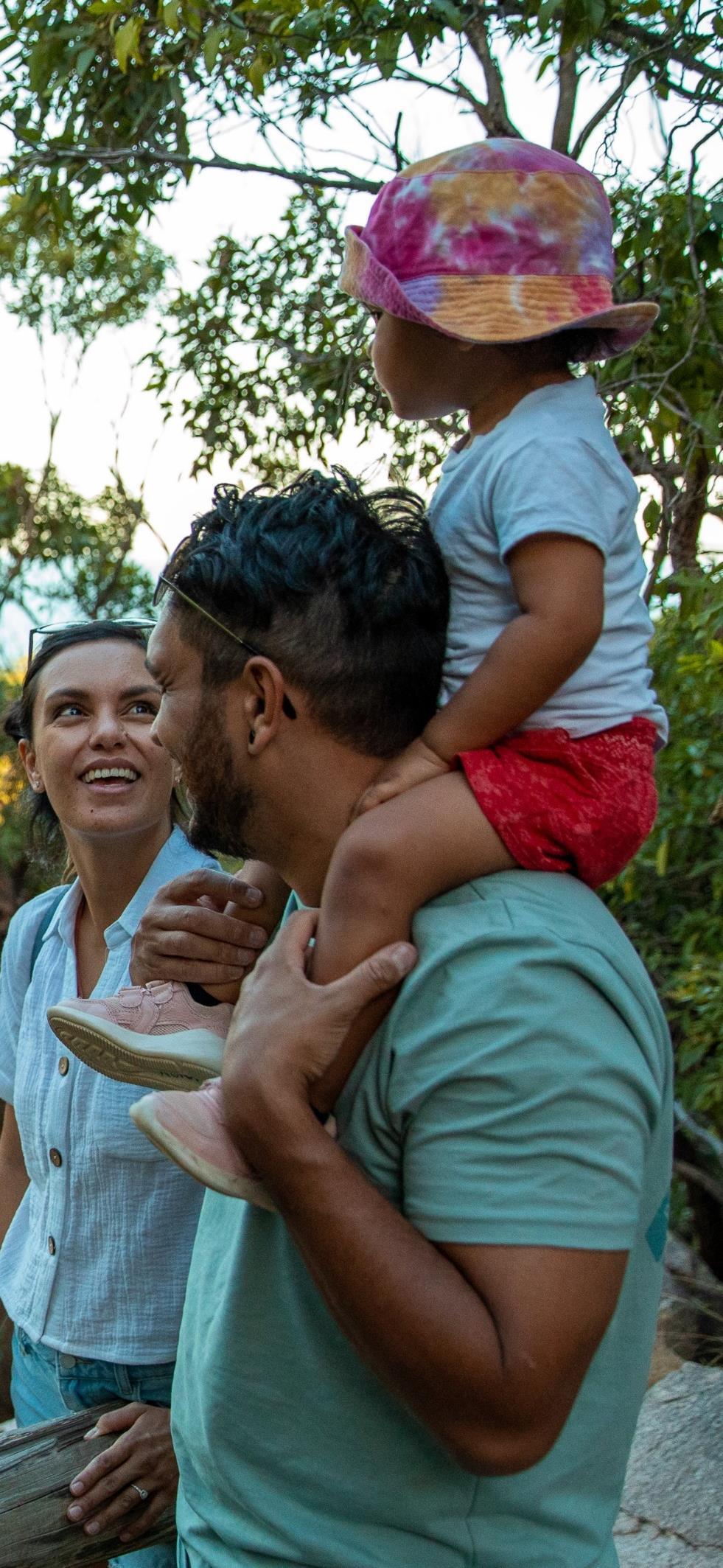
The population and most tourism activity is hosted in four small settlements at Horseshoe Bay, Arcadia, Nelly Bay and Picnic Bay (refer Figure 2).
• Nelly Bay is a primary service centre and gateway to the island, with tourist accommodation and centre facilities
• Arcadia is predominantly residential area, with access to its own local shops, a new community hub, and some small-scale tourism accommodation
• Picnic Bay is predominantly residential area, with access to its own local shops, a new community hub, and some small-scale tourism accommodation
• Horseshoe Bay is predominantly residential community, with some small scale tourism accommodation and activities.
The island has several active community groups including the Magnetic Island Community Development Association (MICDA), Magnetic Island Residents and Ratepayers Association (MIRRA), Magnetic Island Tourism Association (MITA). MICDA and Magnetic Island Nature Care Association (MINCA) and Arcadia Coast Care are very active in the rehabilitation of degraded landscapes, protection of island ecosystems and community sustainability.
In summary, the island’s natural and cultural diversity is valued by the community and visitors. The community has a deep commitment to protecting its uniqueness and authenticity and for fostering the growth of the right kind of tourism. The future depends on a vibrant tourism industry that showcases and enhances the island's extraordinary natural and cultural values and provides socioeconomic benefits for the community.
Magnetic Island (Yunbenun) Tourism Masterplan - 2023 12
2.4
Magnetic Island’s Visitor Economy
Magnetic Island is a key driver of economic activity for the broader North Queensland economy. Tourism to Magnetic Island and the broader region experienced significant growth in the three years prior to 2019, which signalled the start to the COVID – 19 pandemic In 2018-19 the island received a total of 290,3994 visitors. Within the same year, the island generated the significant economic activity for the North Queensland economy:
• $380.2 million in economic output for businesses within North Queensland (including $170.5 million in direct impacts)

• $202.8 million contribution to Gross Regional Product (GRP) (including $90.2 million through direct impacts)
• $107.4 million in incomes and salaries paid to North Queensland households (including $54.5 million in direct incomes)
• employment totalling 1,746 Full Time Equivalent (FTE) jobs (including 1,041 direct FTE jobs).
In 2017-18 Magnetic Island generated GRP of $90.9 million, representing 1.8% growth in the previous year. Until this time GRP had been decreasing by approximately -1.4% on average per annum since 2006-07. The largest annual decrease in GRP occurred between 2013-14 and 2014-15. This is attributed to the decline in the construction sector, potentially resulting from reduced investment in Magnetic Island Notably, the largest contributor to GRP in Magnetic Island is ownership of dwellings at 27.8%, followed by accommodation and food services at 18.0% in 2017-18. Construction is the third largest contributor to GRP (7.2%), which supports the provision of housing and accommodation for residents and visitors. This reflects the importance of the need for mechanisms to attract investment to the island to support economic growth.
The main employment on the island is in accommodation, food services and retail.5 There are around 211 businesses operating on Magnetic Island including accommodation, restaurants, various shops, transport operators and a golf course.6
Of relevance is the greater number of retirees and seniors on Magnetic Island than the regional Queensland average People aged 65 years and over make up 25% of the population on the island7
7 https://profile.id.com.au/townsville/service-agegroups?WebID=320&EndYear=2006&DataType=UR&Sex=3
Magnetic Island (Yunbenun) Tourism Masterplan - 2023 13
4 Magnetic Island Economic Assessment Final AEC 2019 5 Ibid 6 Ibid
Figure 3. Magnetic Island visitor economy
2.5 Townsville Region’s Visitor Economy
Prior to the Covid – 19 pandemic visitor numbers in the region peaked with 1.6 million overnight visitors and 6.4 million visitor nights in 2019.8 The region experienced significant growth in the three years prior to 2019 of 6.8%. Total overnight expenditure to the region was $969 million. Notably, visitor spend in the region was and continues to be below the State average for both domestic and international visitors. By December 2021, total overnight expenditure decreased by 11.9% compared with the preCOVID year ending December 2019 to $779.6m. This decrease occurred on the back of visitation declining by 26.2% to 1.1m.

Domestic visitation was down 19.1% compared to 2019 to 1.0 million. However, total overnight expenditure only decreased by 1.4 per cent to $778.4m. This was because visitors both stayed longer and spent more per night. The main visitor source markets for the region are intrastate visitors.
Importantly, the purpose for travel has shifted. Historically, Townsville North Queensland has proportionately skewed to stronger, businessrelated domestic travel, however the region is now experiencing an increased demand for leisure travel by comparison.
The Regional Tourism Organisation is Townsville Enterprise Limited and their objective is to increase visitor nights and expenditure from both domestic and international markets. 9 Magnetic Island is well positioned to contribute to this objective.
Further analysis is presented in Appendix 1
Magnetic Island (Yunbenun) Tourism Masterplan - 2023 14
8 Tourism Research Australia, Townsville Regional Snapshot 2019
9 Product and Experience Development Plan 2019-2024 Townsville Enterprise 2019

3. Strategic Alignment
3.1 Overview
Changing visitor and community expectations in the last decade have shifted the perspective of tourism growth from one focused purely on economic return to one of sustainable growth. As such, many of the policies and strategies associated with tourism in Australia and Queensland have recognised this shift. The Magnetic Island Masterplan will need to align with these strategies to drive growth. The main strategies and policies are summarised in Table 1
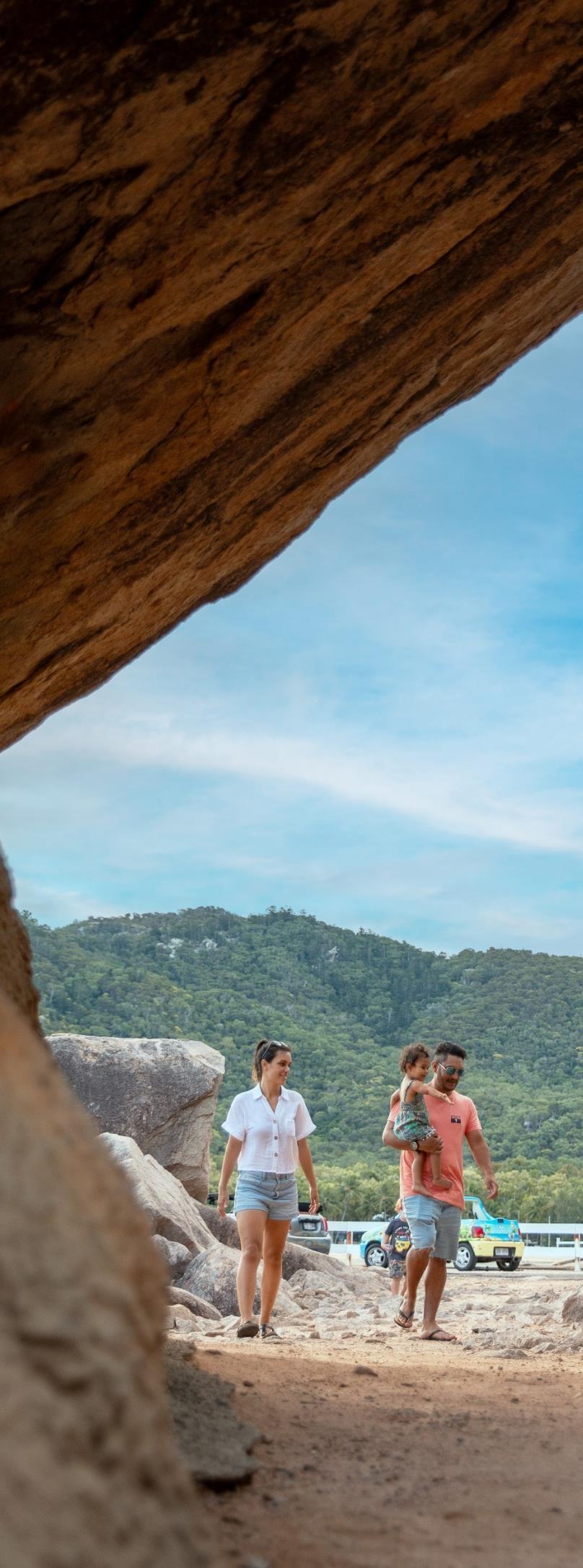
Magnetic Island (Yunbenun) Tourism Masterplan - 2023 16
This section summarises the range of plans and strategies that will impact on the growth of Magnetic Island’s visitor economy over the next decade.
Table 1. Strategic Alignment Level Focus Objectives Strategy/Plans
Federal/State/ Local Governments
15-year commitment for Townsville to accelerate growth and job creation, stimulate urban renewal and drive economic reforms.
Federal Government Tourism
Great Barrier Marine Park and World Heritage Area
State Government Tourism
To establish Townsville as the economic gateway to Asia and Northern Australia; a global leader in tropical and marine research and innovation and a prosperous and highly liveable city for residents and visitors.
Total visitor expenditure in the range of $195 billion to $270 billion, with a focus on achieving $230 billion. The aim is to have regional Australia capture $100 billion, or 44 per cent of this spend.
By 2025 the Great Barrier Reef will be recognised as a world leader in responsible reef tourism and best practice reef interpretation (in partnership with QLD Government)
By 2032 Queensland will be Australia’s destination of choice for domestic and global visitors seeking the world’s best experiences.
Climate Resilience Supports businesses and communities to transition to a low carbon future and build resilience.
First nations tourism Supports the growth of Indigenous business and partnerships and increasing Indigenous participation in tourism, generating jobs and economic outcomes.
Townsville City Deal
Queensland Parks and Wildlife Service
Magnetic Island's protected area estate is managed to protect its rich natural and cultural heritage values and to provide opportunities for visitors and residents to experience nature-based recreation in a natural setting.
THRIVE 2030
Great Barrier Reef Tourism Management Action Strategy
Towards Tourism 2032 Action Plan for Tourism Recovery
Nature-based Tourism Strategy 2021 – 2024
Decarbonisation of Great Barrier Reef Islands –Whole of Community Pilot Project
Wulgurukaba People
Indigenous Land Use Agreement
Queensland Tourism Industry Council’s First Nations Tourism Plan
QPWS Magnetic Island (Yunbenun) Management Statement 2013 (currently being updated) Magnetic island Trails –Vision Plan (TCC and QPWS)
Magnetic Island (Yunbenun) Tourism Masterplan - 2023 17
Level Focus Objectives Strategy/Plans
Local Government Townsville City Council Economic and social prosperity for Townsville and region.
Townville City Plan
Strategic Asset Maintenance Plan
Townsville 2021 – 2026
Magnetic Island Trails –Vision Plan (TCC and QPWS)
Townsville Enterprise Limited
Community
Magnetic Island Community Development Association
Economic development for the Townsville region through tourism (acts as Regional Tourism Organisation).
A united community which celebrates diversity and derives adequate income and employment, having a satisfactory range of facilities and services and a fulfilling lifestyle from experiencing and caring for the unique world heritage and village like environment and providing the opportunity to share with visitors.
North Queensland Regional Plan 2020
Product and Experience Development Plan 2019 – 2024
Magnetic Island
Community Action Plan
Magnetic Island Community Development Association
The World Heritage Island Plan will be established under a series of community based working groups. The strategic objectives of the plan are to:
1) To preserve, protect and promote our Island’s World Heritage natural, cultural, and social values.
2) To decarbonise and improve sustainability of services & utilities to, around and on our Island.
3) To enhance and improve community and visitor wellbeing, lifestyle, experiences, knowledge, and stewardship of our Island.
Our World Heritage Island” Plan (under development)
Magnetic Island (Yunbenun) Tourism Masterplan - 2023 18
3.2 Regional Demand Drivers
In addition to the strategies and plans presented in Table 1 there are some significant regional developments planned for the next ten years that will drive visitor growth
2032 Brisbane Olympic and Paralympic Games
The Olympic and Paralympic Games forecast a tourism injection of more than $20 billion into the state's economy, including $10 billion for regional areas. In addition to whole-of-State benefits, Townsville and potentially Magnetic Island could benefit from a range of opportunities, including destination marketing and pre and post touring opportunities 10
Centre of Excellence in Marine Science
The Townsville City Deal aims to position Townsville as a global leader in tropical and marine research and innovation. Magnetic Island’s location within GBRWHA and proximity to Townsville means it can leverage this opportunity in partnership with education and research institutions such as James Cook University and the Australian Institute of Marine Science as well as the GBRMPA to offer a range of experiential tourism opportunities in natural, cultural and social themes.
Reef HQ Great Barrier Reef Aquarium
The $80 million redevelopment of Reef HQ Great Barrier Reef Aquarium will significantly increase Townsville's appeal as an international education and training destination and the opportunity to view and learn about the Great Barrier Reef. Reef HQ delivers both in-house and outreach education programs and there is significant potential for edu-tourism partnerships with Magnetic Island offering ‘hands on’ regenerative tourism experiences.
3.3 Management Responsibilities
Townsville City Council
Townsville City Council (TCC) plays an essential role in facilitating appropriate tourism development and associated services and facilities on Magnetic Island. TCC works with Townsville Enterprise Limited, the Regional Tourism Organisation, on activities including investment in public infrastructure (e.g., water, waste roads), experience development, investment attraction and events.
Providing and maintaining services (e.g., utilities) and public infrastructure (e.g., jetties, public airstrips, ferry terminals) on Magnetic Island are a significant capital and operational cost to the State Government and its partners. Ensuring these requirements are developed and maintained are an important part of establishing tourism operations, but also in supporting business and residential requirements. Moorings, marinas and jetties are the responsibility of State Government. The Queensland Government partners with TCC and the Australian Government to invest in infrastructure on the island.
Townsville Enterprise Limited
Townsville Enterprise Limited (TEL) is the peak economic development agency in North Queensland, representing the interests of five Local Government Areas. It is also the region’s Regional Tourism Organisation and Convention Bureau. Its mandate includes increased visitation and expenditure, enhanced awareness of the destination, experience development, event development and activation, and aviation and cruise attraction.
Wulgurukaba Traditional Owners
The Wulgurukaba Aboriginal Corporation and the Wulgurukaba Yunbenun Aboriginal Corporation represent the Wulgurukaba people and have registered an Indigenous Land Use Agreement (ILUA). They own six hectares of land on Magnetic Island as a freehold title under the Aboriginal Land Act 1991 Their objectives include managing their lands as defined in the ILUA, establishing cultural heritage tourism and attaining self-sufficiency by development of economic projects and industries11
Magnetic Island (Yunbenun) Tourism Masterplan - 2023 19
10 2032 Olympic and Paralympic Games, Value Proposition Assessment Executive Summary, Queensland Government 2019
11 Magnetic Island (Yunbenun) Management Statement, June 2013, Department of National Park Recreation Sport and Racing
Queensland Parks and Wildlife ServiceMagnetic Island National Park
The Queensland Parks and Wildlife Service (QPWS) play a key role in terrestrial and marine management for the majority of Magnetic Island and surrounding waters They are responsible for management of the protected area estate on Magnetic Island, which represents 78% of the land.
In partnership with GBRMPA, the QPWS manages the surrounding tidal lands and waters of the Great Barrier Reef Coast Marine Park in line with specific objectives for supporting tourism on and around Magnetic Island MINCA are the trustees for Bolger Bay Conservation Park
QPWS works collaboratively with Wulgurukaba people through the Yunbenun Advisory Group
Collaboration between TCC and QPWS has enabled planning and implementation of the Magnetic Island through the Magnetic Island Trails Vision Plan to improve the walking trail network. QPWS has made significant investments on Magnetic Island. They are responsible for managing most of the walking trail network on the island, which are a key visitor attraction. Recent QPWS projects include:
• Fort Junction Hub Upgrade - $2.35 million upgrade to this key visitor hub, entrance to the National Park and start of the Forts Walking Track (Funded by the Queensland Government and led by QPWS)
• Nelly to Arcadia walking track rebuild - $500k investment to rebuild this National Park walking track linking Nelly Bay to Arcadia and the Forts Junction (Funded by the Queensland Government and led by QPWS)
• Magnetic Island National Park walking track network - $1.5 million investment into the National Park walking track network, including the new Forts to Florence Bay walking track, upgrades to the Forts Circuit track, and improved visitor orientation (Funded by the Commonwealth Government and led by QPWS)
Other State Government Agencies
Other agencies within the Queensland State Government also enable the growth of the visitor economy by ensuring policy and funding decisions support infrastructure for both the residents and visitors to Magnetic Island, such as the Department of Tourism, Innovation and Sport (DTIS) and the Department of Transport and Main Roads (DTMR). For example, the Queensland Government’s Decarbonisation of the Great Barrier Reef Islands program (managed by the Department of Environment and Science) supports businesses and communities to transition to a low carbon future and build resilience. Funding is offered through the Queensland Climate Resilient Councils program to support the rollout of priority projects for several islands, including Magnetic Island. The Magnetic Island assessment included 18 project options which would create 11.5 jobs, reduce annual carbon emissions by 22,130 tonnes and generate $2.9 million in savings annually. The outcomes of this assessment are yet to be prioritised and funded.
Great Barrier Reef Marine Park Authority
The Great Barrier Reef Marine Park Authority works with all levels of government to implement the Reef 2050 Long-term Sustainability Plan. QPWS works with the Great Barrier Reef Marine Park Authority and the Reef tourism industry, and the Australian Government and Tourism Australia to convey the depth of the Great Barrier Reef story to educate and inspire travellers, generate positive media coverage, and assist tourism operators to deliver transformative visitor experiences.
The Great Barrier Reef Marine Park Authority and the Queensland Parks and Wildlife Service operate a joint Field Management Program for the marine and island national parks. The program delivers practical on-ground actions to protect and maintain wellfunctioning marine and island ecosystems that support economic, traditional and recreational uses of the Great Barrier Reef.
GBRMPA is based in Townsville, creating an opportunity for Townsville to be the Edu-Tourism location for students around the world to learn about the Reef and the issues facing it. Importantly, by 2025 the collective aspiration is that the Great Barrier Reef will be recognised as a world leader in responsible reef tourism and best practice reef interpretation. This presents a significant opportunity for Magnetic Island.
Refer to Appendix 2 for further information on infrastructure.
Magnetic Island (Yunbenun) Tourism Masterplan - 2023 20

4. Key Visitor Markets
4.3 International High Value Travellers
4.1 Overview
Understanding the target markets for tourism to the Townsville region (including market size, characteristics, preferences, etc) is critical to identifying future strategic marketing initiatives, as well as product and infrastructure requirements to attract these visitor segments to Magnetic Island
The descriptions of the market segments are based on information sourced from TEQ, which, as the organisation responsible for marketing destinations, determines the state-wide target markets for the Regional Tourism Organisations, including TEL.
TEL is focussed on two markets for the Townsville Region visitor economy (of which Magnetic Island is a part), and each of them are important. While they are of comparable size, the behaviours, itineraries, booking patterns and, importantly, expenditure per visitor, are vastly different. The focus is on markets travelling to the region for leisure, not business, and they are known as High Value Travellers.
4.2 Domestic High Value Travellers
Domestic HVTs engage in holiday or VFR travel; spend more than the average traveller during leisure holidays (>$2,000 per trip, or $300 per night for shorter trips); and are willing to pay for and experience dining options, tours and attractions. According to TEQ, HVT represents approximately 1.1 million Queenslanders (intrastate visitors) and approximately 4.2 million other Australians (interstate visitors) Therefore, there are a total of over 5.3 million domestic visitors that are classified as HVT.
Classifying HVT as a target market is designed to generate increases in visitor value (rather than focusing solely on volume). Magnetic Island has the potential to become a high-value destination by attracting high value visitor segments. This Masterplan focuses on relevant marketing and product opportunities to attract these market segments.
International HVTs undertake long-haul trips on a regular basis; have a preference to visit Australia; choose holiday destinations based on key drivers such as aquatic and coastal as well as wildlife, nature and adventure; prefer self-drive holidays; and represent above average trip expenditure with higher likelihood to stay longer and disperse further
TEQ currently targets Experience Seekers. The international experience seeker/self-drive market is identified as a key market by Tourism Australia. Experience seekers are not characterised by nationality but seek out authentic experiences which are engaging and have an educational element. This market exhibits the following characteristics and holiday preferences:
• affluent and well-educated professionals
• tends to spend more than the average international visitor
• seeks authentic local experiences and social interactions
• wants to participate in and learn about different lifestyles and cultures; and
• visits authentic and unique destinations.
At present, international experience seekers do not make up a large portion of visitation to the region, however, there is an opportunity to grow this market with appropriate nature-based experiences and development of supporting products and services. As such, international experience seekers are more likely to visit regional areas, stay longer in the Region, and are less attracted to ‘mass packaged tourism products’.
Magnetic Island (Yunbenun) Tourism Masterplan - 2023 22
This section provides an assessment of the key visitor markets for Magnetic Island that are influenced by regional, state and national approaches to target markets.
4.4 Domestic high value traveller visitor segmentation12
Coastal/beach
Holiday
Holiday Types (ranked)
Holiday
Holiday
Magnetic Island (Yunbenun) Tourism Masterplan - 2023 23
Intrastate Interstate Estimated Market Size 288,000 1,400,000 Origin 50% Brisbane 50% Other QLD 33% Sydney 24% Melbourne
Characteristics Lower income
local holidays Affluent families
poor
Table 2. Travelling with children
Key
Prefer
Time
(work and social life)
Holiday Preferences (ranked) Value for money Family destination
destination
Coastal/beach Family
Value for money
Beach
Resort
Resort holiday
Types (ranked) Short break
holiday
holiday Short break Beach holiday
Intrastate Interstate Estimated Market Size 408,000 1,300,000 Origin 49% Brisbane 51% Other QLD 34% Sydney 27% Melbourne Key Characteristics White collar professionals Focus on health & entertainment White collar professionals Propensity to spend more
Table 3. Travelling without children (18-49)
Adventure
for money
& Wine Unique experiences
Holiday Preferences (ranked) Value for money Coastal/beach
Value
Food
Short
Beach holiday Discovery Short break City break Discovery
break
Intrastate Interstate Estimated Market Size 440,000 1,500,000 Origin 45% Brisbane 55% Other QLD 27% Melbourne 22% Sydney
Characteristics
workers
Retirees/part-time workers
time for leisure activities
Table 4. Travelling without children (50+)
Key
Retirees/part-time
Lead a more relaxed lifestyle
Spare
money
&
Preferences (ranked) Value for money Food & Wine Coastal/beach Value for
Food
Wine History & Heritage
Discovery Dispersal Short break Discovery 12 TEQ, Domestic High Value Traveller Profiles, 2018
Types (ranked) Short break Dispersal to multiple locations

5. Visitor Experience and Product Profile
5.1 Branding and Positioning
Research on the positioning of the Townsville and North Queensland region as a destination13 provides useful insights as to how Magnetic Island is perceived by consumers.
The top five drivers for visitors to visit the region are important for Magnetic Island. The research shows that these are places or experiences that visitors cannot do elsewhere including ‘experiences that provide a sense of discovery and exploration, ‘a food and dining scene, a different vibe from my everyday life or allow me to connect with nature and wildlife’. Importantly, key areas where other destinations are outperforming the region include:
• iconic and World Class
• ‘holiday’ allure
• social cachet when compared to other Queensland destinations.
Magnetic Island is perceived as a ‘hero’ experience for the region, but it is low on the list of associations. What we can learn is that the barriers to holidaying in Townsville include:
• lack of hero or drawcard features and no clear or compelling reason to choose Townville
• a lot of other iconic Queensland choices
• little or no knowledge of Magnetic Island.
5.2 What this means for Magnetic Island
Despite its location, Magnetic Island is not associated with the Great Barrier Reef as a destination. However, the research indicates that Magnetic Island has a significant opportunity to leverage its position within the Great Barrier Reef World Heritage Area and offer unfiltered, authentic experiences and sense of discovery that visitors are looking for.14 It can offer visitors the opportunity to break free from the resort style destinations islands that other Queensland islands offer.
Product Profile
The strengths that define the perceptions of Magnetic Island are presented in Table 5. The product and experience strengths are categorised as:
• primary – well-established strengths, synonymous with Magnetic Island and helps define its competitive advantage
• secondary – tourism product that has a smaller presence but provides an important complementary offering for visitors. Secondary product typically requires further developments and improvements
• emerging – tourism product that is either new or limited and can develop over time.
The experience and product profile shows that the primary appeal of Magnetic Island as a visitor destination largely relates to its nature-based assets (based on the product strengths). This includes Magnetic Island National Park, the Magnetic Island Forts Complex, walking trails, wildlife, attractive beaches, and reefs. Many tourism attractions and products have been developed to capitalise on these unique natural settings and provide a high-quality visitor experience. These include bush walking, birdwatching, boat trips, snorkelling trails and tours, bus tours, water sports, golf, diving expeditions, jet skiing and fishing. Of the total number of operators, only 37 are listed on the Australian Tourism Data Warehouse (ATDW), Australia’s online marketplace for tourism information. Nineteen operators have achieved the TEQ’s “Best of Queensland” status. Further development of the secondary and emerging strengths (e.g. food & beverage, arts & culture, health & wellbeing) has the potential to transform these products into primary strengths. Additional investment and resources should, therefore, be targeted to areas of need to grow the visitor market and increase visitor yield.
14 Ibid
Magnetic Island (Yunbenun) Tourism Masterplan - 2023 25
13 Townsville Brand Project Research, The Lab 2022
Appropriate investment to improve existing (and develop new) products and experiences that leverage the island’s strengths will support growth and enhance the visitor economy in terms of value and volume. These attractions alone, however, are only likely to sustain the island’s tourism
PRODUCT TYPE
Nature and outdoors
Aboriginal Heritage
Arts and Culture
Food and Beverage
Health and Wellbeing
Events and Festivals
Aquatic/marine

Eco Tourism/Edu Tourism
growth unless are aligned with contemporary ‘globalised’ standards relating to quality, the provision of specific sought-after experiences and how well the industry can meet the needs and expectation of visitors
Eco Accommodation
Magnetic Island (Yunbenun) Tourism Masterplan -
Table 5. Product and Experiences Evaluation – Primary, Secondary and Emerging
Primary Secondary Emerging
5.3 Product Gaps and Opportunities
Table 6 summarises the gaps in the island’s product and experiences, as well as the opportunities to improve the product strengths, enhance the visitor experience and facilitate growth in the tourism industry. The opportunities are designed to leverage the existing and emerging product strengths and increase the value of visitation by catering to the needs to the visitor market.
Arrival Point
For visitors the arrival experience is very much designed for commuters with little orientation information or sense of arrival on an island in the GBR World Heritage Area. It is important to have appropriate infrastructure that is in keeping with the World Heritage experience and the low-key character of the island. Infrastructure that is not in keeping with this character detracts from these values and impacts the overall Magnetic Island product.
Villages
Most tourism activity is hosted in four small settlements at Horseshoe Bay, Arcadia, Nelly Bay and Picnic Bay.
On arrival visitors need to feel they have arrived at a unique and special place, to connect with the island’s values and how to protect them, in an environment reflective of the island’s character.
An arrival space and a clear orientation point at the ferry terminal to strengthen Magnetic Island’s identity, signify arrival and link visitors to other precincts and sites of interest on the island through complementary infrastructure and common themes that set the scene for the rest of the island experience.
Magnetic Island’s unique villages lack quality and character to draw visitors to each of the villages as a destination and encourage longer stays to explore the Island.
Strengthening the identity and character of the four villages and revitalising infrastructure will improve their destination value. Individual villages require streetscape plans to provide the retail mix and key tourism services sought by visitors. They also need to be linked together with common themes for a holistic experience across the island.
Nature tourism
The island has a diverse range of nature-based assets, including the National Park, beaches and a variety of supporting outdoor activities (e.g. walking and snorkelling trails, water sports etc.).
There are gaps in the nature-based tourism offering and more commissionable tourism product and supporting visitor amenities are required.
Greater investment in experiences, facilities and supporting infrastructure to strengthen the nature-based assets, connect existing opportunities and activate the island’s position within the GBR World Heritage Area.
Heritage and Arts
There are a small number of heritage experiences on offer. The Forts Complex is the major attraction. The Magnetic Island History and
There is a general lack of linked experiences relating to heritage and arts. Considerable investment is occurring in QPWS
Better integration of interpretation to promote Island’s history and heritage will enhance the visitor experience.
Magnetic Island (Yunbenun) Tourism Masterplan - 2023 27
Table 6. Product Gaps and Opportunities
Category Description Gaps & Constraints Improvement Opportunities
Category Description Gaps & Constraints
Craft Centre and Museum offer visitors some information about the island’s interesting heritage.
Wulgurukaba Culture
There are limited opportunities for visitors to connect with Wulgurukaba culture on Magnetic Island.
interpretive signage as part of the Magnetic Island Walking Track Master Plan.
This is a significant opportunity and the Wulgurukaba Traditional Owners have expressed interest in realising opportunities to share their culture with visitors on the island.
Events
The island has an annual tourism events profile dominated by small-scale events attracting low visitor numbers. The largest proportion of events are sport and recreation events, including participatory and spectator events.
Health and Wellbeing
Health and wellbeing product is growing in popularity.
There is a major gap in events that are aligned to contemporary visitor interests and expectations.
Improvement Opportunities
Arts & culture tourism opportunities can be supported by local community with improved interpretation and art installations in village areas.
Investment in Indigenous cultural experiences and interpretation to grow cultural tourism and support Traditional Owners.
There is a need for development of new events such as, marine, arts and culture events, major music events
Food and Beverage
The island provides a range of food & beverage product for visitors
Health & wellbeing product is lacking and mostly integrated with the accommodation. There is a lack of dedicated facilities (e.g. day spas)
There are several gaps with tourist related food and beverage product that constrains its ability to drive visitor yield, including lack of local produce or ‘destination dining’ establishments, limited late night dining options and closures during week nights or off peak periods.
Eco /edu and regenerative tourism
Most experiences offered centred on adventure-based activities, with some opportunities for eco tourism.
There is a significant gap in island regeneration experiences that involve terrestrial, marine or wildlife experiences.
There are opportunities to leverage the natural assets and branding of the Magnetic Island and develop more facilities of this nature.
There are several opportunities including better coordination and communication about venue opening hours, consistency of service and the extension of evening operations as well as ‘island vibe’ night markets and pop up food vans.
Integrate eco accommodation, cultural immersion, marine science activities, the walking track network, marine trails, snorkel trails, interpretation, Wulgurukaba walking tours, locally sourced food and beverage, and events.
Magnetic Island (Yunbenun) Tourism Masterplan - 2023 28
Accommodation Profile
The island offers a range of accommodation for visitors. The accommodation supply is predominantly ‘upper midscale’-quality serviced accommodation that cater to the family and VFR markets The average room rate is between $150 and $200 a night.

Across the main accommodation on Magnetic Island (11 mainstream properties) there are approximately 600 beds. Approximately 270 are backpacker/hostel, 100 are 4+ star and the rest mid-range 3 star. The average occupancy rates is around 75%, noting that this is also for the Townsville region.
There is one caravan and camping ground with 23 powered sites and 13 unpowered sites. It experiences high occupancy for around twelve weeks of the year.
There is a lack of ‘luxury & upper upscale’ facilities, particularly internationally branded hotels and resorts, which typically attracts highyielding markets (through brand recognition, loyalty programs, etc.).
In addition, given the limited supply of these fullservice hotels inc. business facilities), business travellers are less likely to stay overnight, reducing potential visitor yield.
There is also a significant number of private shortterm holiday rentals on the Island (e.g. Airbnb). As of July 2022, there were 392 listings and occupancy were around 82% 15 This form of (non-commercial) accommodation, is important in supporting current and future visitation growth however it is creating a housing shortage for workers on the island as well as rental affordability.
Magnetic Island (Yunbenun) Tourism Masterplan - 2023 29
15 Air DnA data Townsville Enterprise August 2022
STRENGTHS
Magnetic Island enjoys…
• World Heritage status and areas of the islands protected for conservation
• Natural advantages for tourism such as climate, natural beauty, and environment
• Exceptional abundance of terrestrial and marine wildlife including oldest living corals on the GBR
• Easy and convenient access from Townsville
• Diversity of tourism businesses offering range of accommodation and experiences
• Good transport options around the island
• Appeal as a traditional family holiday destination
• Unique attributes that are different to other QLD islands - uncommercialised
• Vibrant community with welcoming spirit with employment opportunities in Townsville.
• Variety of experiences (nature and heritage) supported by walking trails, with local villages offering accommodation and services for visitors
• High levels of visitor satisfaction
• A strong sense of connection by the Wulgurukaba people and interest in tourism enterprise.
• Highly proactive, environmentally minded local community.
• Support for tourism from the local community
• Consistent growth in visitor numbers and nights
WEAKNESSES
Magnetic Island faces
• Lower than average visitor expenditure when compared to other Queensland destinations
• Limited capacity of some infrastructure including wastewater and parking
• Lack of visually connected, high quality visitor infrastructure. Infrastructure standards are not specific to the island and do not take into account retaining the low-key character of the island and integration into the surrounding natural environment
• Planning scheme perceived to limit investment and lack of incentives resulting in low level of investment
• Limited co-ordination amongst public authorities
• Poor sense of arrival and cultural and environmental orientation
• Limited financial resources for major infrastructure projects
• Labour and worker accommodation shortage
• Higher development and operating costs when compared to mainland
• Limited telecommunication infrastructure impacts on tourism businesses
• No ‘hero’ experience and no clear positioning as part of GBR WHA




• Limited cultural footprint of Wulgurukaba community
• Service quality
OPPORTUNITIES
Magnetic Island can take advantage of…
• Best practice and regenerative tourism – reef, marine and island environment aligned with State Government Recovery Plans
• World’s best classroom for on reef education in partnership with Marine Centre of Excellence in Townsville
• Strong brand identity supported by strong visual identity – design guideline for the island and infrastructure.
• Public/private stakeholders to work together to influence development and management of tourism and to facilitate a joint (strengthened) advocacy and development approach for the island
• Operators ready to invest – they need the right signals and investment certainty from government
• Commercial activation of four villages based on their unique characteristics - revitalised and linked with walking trails and transport options for a whole of island experience.
• A ‘Cinque Terre’ linking marine trails and leveraging walking trail investment with accommodation, experience, and food options.
• Revitalised arrival experience at the ferry terminal as arrival point for orientation
• Community sentiment and support for green and blue economy
• Townsville City Plan and Brisbane Olympics.
THREATS
Magnetic Island can be affected by…
• Unsustainable tourism growth that impacts on the local community
• Dilution of the island’s signature low key character through inappropriate development and infrastructure
• Visitor behaviour that does not align with MI brand values
• Natural disaster and climate change limits tourism to the island
• Investors choose other more attractive destinations
• Lack of investment in public infrastructure impacts on decline in tourism
• Development that changes village character and atmosphere and impacts the overall low-key character of the island
• Public liability insurance impacts experience offering
• Shortage of workers and worker accommodation.
Magnetic Island (Yunbenun) Tourism Masterplan - 2023 30
6. Catalysts for Change
tourism on the island, they are concerned about a number of issues including parking, availability of housing and the cost of infrastructure.
Climate Resilience
The nature of tourism continues to present new opportunities and emerging trends for Magnetic Island’s visitor economy. The following summary highlights the key issues and they have been drawn from consumer research and consultation with industry, government and community stakeholders.
Visitor Needs and Expectations Are Changing
Global population demographics are shifting rapidly, and Magnetic Island, like other visitor economies must adapt to address the changing needs of different traveller cohorts. Increasing focus on the impact of climate change and the environment will increase visitor demand for more eco-friendly and sustainable destinations. Younger travellers are demanding authentic experiences delivered onsite by local experts, and want their interactions digitally enabled throughout the journey
Tourism Sustainability
Sustainable tourism practices are no longer optional - they are considered essential as they help to facilitate long term tourism growth and ensure the Island continues to be a compelling and attractive destination. This is a critical concern for the community.
Community Amenity
As the world changes, so are the values of residents and their communities. A vibrant community is a compelling attraction for visitors. Focussing on the interests of residents and visitors is important in creating successful destinations. While the community are generally supportive of
Key tourism assets and infrastructure across the region, including Magnetic Island will be impacted by high levels of coastal inundation16 These expected changes include:
• damage to coastal infrastructure such as marinas, jetties and wharfs, preventing access to visitors, tourists and supplies
• additional, more costly standards for new investment or reconstruction efforts to better account for increased placing further cost pressures on tourism assets
• reduction in the number of visitors during cyclone season.
Reef Regeneration
Many environmentally aware visitors have moved from wanting their travel to ‘leave no trace’ to wanting to leave destinations they visit ‘better than before’ – now known as regenerative tourism. This is already occurring in other parts of the Great Barrier Reef where there are opportunities for citizen science and voluntourism. By visiting, and in some cases by paying access fees or undertaking work as part of their experience, many visitors are providing the means and the labour to protect and regenerate our natural environments.
Value Over Volume
The Magnetic Island community has acknowledged that there are risks associated with having too many visitors on the island at any own time and that sustainability is a critical requirement for tourism. The island already receives a high volume of visitation. Therefore, to drive growth in the visitor economy destination development will need to focus on the value of the visitor economy via increases in visitor expenditure (yield) rather than high volumes of visitors.
Magnetic Island (Yunbenun) Tourism Masterplan - 2023 31
This section outlines the factors that will influence the future of tourism on Magnetic Island and how we may need to adapt to ensure our visitor economy and community prosperity is assured.
16 Townsville City Council Climate Prepared for the Queensland Department of Tourism Innovation and Sport, AECOM Australia Pty Ltd, May 2022.
Wulgurukaba Connection
There is a strong desire to create mutually beneficial partnerships to build awareness and recognition of Wulgurukaba’s connection to the island and sea country. This includes the development of tourism enterprises and the appropriate incorporation of language, food and stories into visitor experiences. There remains a strong need to support industry development to support Wulgurukaba people and business owners to achieve their own success.
Industry Development
Ongoing promotion and support for industry development will be necessary to increase the capabilities of the tourism industry and better meet the needs and expectations of visitors. In doing so, the industry can help enhance the visitor experience and facilitate tourism growth.
Public Infrastructure to Support Growth
A high level of capital is required to support the replacement and maintenance of critical infrastructure to service the needs of visitors. This investment often falls to Townsville City Council and the Queensland State Government. Within this context, it is often assessed as a residential/community need rather than a tourism priority. It is necessary to prioritise investment for infrastructure that will also support tourism investment. For example, a solution to increase the capacity of wastewater treatment to service increased demand will be necessary.
Allocating responsibility for infrastructure provision through fair apportionment processes, whilst facilitating tourism investment is a challenge for all local governments. In the case of Magnetic Island this issue is particularly important as the capacity constraints on Council-provided infrastructure can be considered a barrier as infrastructure charges and associated costs can be a significant issue for tourism developments.
The use of design standards geared toward preserving the low-key character of the island, connecting the island-wide experience and promoting common interpretive themes is essential to supporting future investment in public
infrastructure Sustainability and the integration of climate resilience considerations into all infrastructure planning is also fundamental.
Investigate Options for Infrastructure Funding
Many leading tourist destinations around the world are investigating how to increase revenue through other mechanisms including visitor levies without any evidence of negative impacts on visitation and the destination’s tourism operators. A levy can provide the necessary tourism funding to support and infrastructure and promotion. This is critical to ensure the long-term sustainability of the island.
Attracting and Facilitating Investment
Ongoing co-investment in infrastructure will be necessary to facilitate tourism investment on Magnetic Island. As with other island destinations, Magnetic Island has significantly higher operating costs (e.g., workforce expenses, utilities, waste treatment and removal and insurance). These additional costs create significant barriers to investment with investors often choosing other mainland destinations for commercial viability and greater return on investment.
De-risking development proposals by addressing significant site constraints and challenges is critical. Considerations include supporting development proposal(s) by leading and funding the provision of strategic headwork services such as potable water and sewer services or sharing the costs of upgrading site specific enabling infrastructure such as roads, power and telecommunications.
Magnetic Island (Yunbenun) Tourism Masterplan - 2023 32
Planning Scheme
The Townsville City Plan recognises Magnetic Island as a major tourist destination for Townsville. It seeks to maintain accommodation and recreation activities at a scale and form relative to the island's overall character. As a performance-based planning scheme, the Townsville City Plan can accommodate variation, innovation, unforeseen uses and development or circumstances irregular to a particular application to produce results beneficial to the community. New developments are assessed against their merits and impacts; should a proposed development require adjustments to zoning or overlays, potential scheme amendments are considered and publicly consulted.
Insurance
In addition to increasing property insurance costs, many tourism operators are struggling to purchase public liability insurance placing real constraints on the development and operation of adventure experiences. The market failure is complicated by global factors, state and federal regulation, natural disasters, and increased litigation. The Australian Government’s visitor economy strategy, THRIVE 2030, includes an action to encourage the provision of accessible and affordable insurance for visitor economy businesses.
Partnerships and Collaboration
The island has a complex assortment of agencies that each operate independently and the current approach to tourism development is fragmented. Ongoing efforts will be required to bring together all the relevant agencies, industry and community to address co-ordinate activities, address specific tourism related issues and secure investment that strengthens benefits for residents and visitors.
Labour and Worker Accommodation Shortages
The ability to attract and retain suitably skilled employees is challenging, with high costs of recruitment and training, along with the seasonal (transient) nature of employment. Over peak periods the high demand for accommodation on the island is displacing availability of accommodation for key workers which is further compounding labour shortages.
Short Term Accommodation
In the past ten years, destinations have experienced a significant shift in the way people use accommodation on their holidays. Services such as Airbnb offer travellers the opportunity to experience a more ‘local’ setting, while allowing residents to gain an alternative source of revenue from their own home. Uses of residential properties for ‘tourism’ purposes can place additional strain on local government infrastructure where that infrastructure was not designed to accommodate that extra demand generated by tourists. Meanwhile, landowner ‘hosts’ may have been able to benefit from the additional revenue of these services without having to provide a fair contribution for the additional burden placed on local government infrastructure.
Given the high number of short term rental accommodation properties on Magnetic Island, consideration should be given to regulate the use of residential properties for tourism purposes, by levying differential rates, with a higher rate applying to those properties used for tourism purposes.
Telecommunication Infrastructure
Telecommunications blackspots across Magnetic Island inhibit connectivity for some operators, restricting development of premium tourism products.
Magnetic Island (Yunbenun) Tourism Masterplan - 2023 33
PART B –Magnetic Island (Yunbenun) Tourism Masterplan – Priorities and Actions

Our Vision
To be a world leading sustainable island destination inspiring land and reef stewardship that enhances the quality of life of our community and strengthens the cultural identity of our island home.
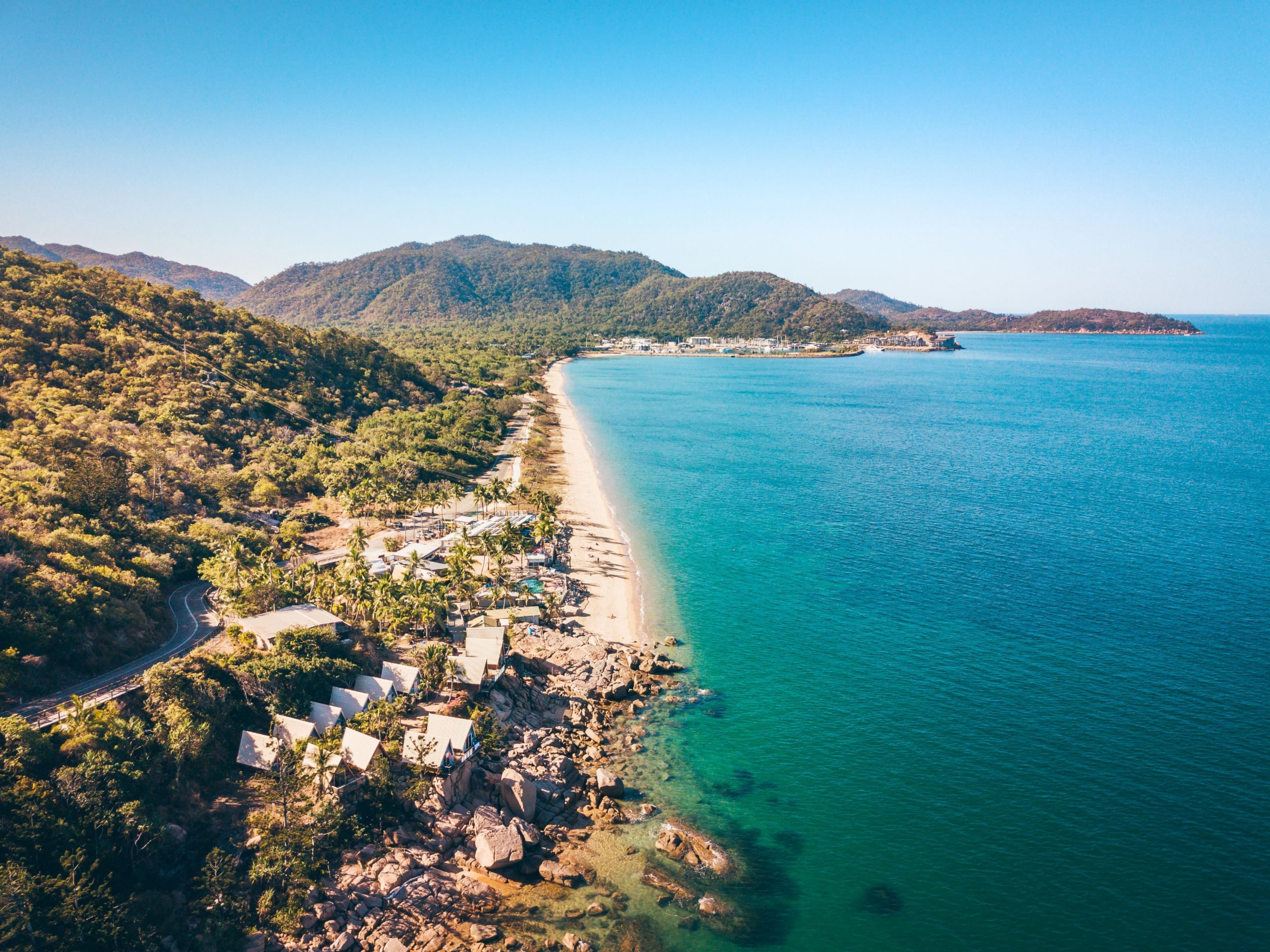
7. A New Framework for Tourism on Magnetic Island
The following section provides the overarching approach to strategic tourism development on Magnetic Island. The plan is based on background research, consultation and key considerations for the island and region as presented in Part A.
It includes the shared vision for tourism on the island, our objectives for tourism and future projects that will help us achieve them. The objectives and actions are designed to address the gaps and opportunities identified in Section Part A and include a combination of actions that address branding, experience and product development leadership, co-ordination and partnership initiatives
7.1 Our vision and objectives
Our vision is to be a world leading sustainable island destination inspiring land and reef stewardship that enhances the quality of life of our community and strengthens the cultural identity of our island home Our objectives are presented in Figure 3
7.2 Objectives




FOR OUR COMMUNITY
Enhance the quality of life for residents and increase connection with Traditional Owners, by working with the community to plan the most appropriate types of tourism that support their wellbeing and prosperity.
FOR OUR VISITORS
Deliver exceptional experiences tailored to attract and satisfy the high value traveller, maximising satisfaction resulting in increased length of stay, expenditure and dispersal across the year.
FOR OUR INDUSTRY
Stimulate and support competitive and sustainable tourism businesses that will attract and satisfy target markets and maximise social, economic and cultural benefits to the community.
FOR LAND AND SEA COUNTRY
Implement sustainable tourism practices, in partnership with national, regional and local stakeholders, implementing programs designed to protect the values of Magnetic Island and the Great Barrier Reef World Heritage Area.
Magnetic Island (Yunbenun) Tourism Masterplan - 2023 36
7.3 Destination Development Themes
The following development pillars have been identified for Magnetic Island. They are categorised into Tourism-Specific Themes and Tourism Enabling Themes, each of which is aligned to an overarching objective that will help with the identification of specific projects and strategies designed to support sustainable tourism growth.









• tourism-specific themes will directly influence the visitor economy and deliver/ enhance the island’s competitive advantages to achieve the stated vision
• tourism-enabling themes will indirectly influence the visitor economy through stewardship of Magnetic Island as a destination and strengthen investment attraction, co-ordination and industry capacity.
Actionable initiatives and priority projects identified throughout the consultation process have been grouped under each theme. While each theme is important in and of itself, the strength of the Magnetic Island (Yunbenun) Tourism Masterplan and the success by which it is measured will stem from the need to ensure they are interconnected and pursued in balance.
Magnetic Island (Yunbenun) Tourism Masterplan - 2023 37
A new business model – a community of partners, innovators and entrepreneurs Public & private Investment that supports the vision A thriving and prosperous island community World class visitor experiences in the world’s most precious marine ecosystem
Figure 4. Magnetic Island Tourism Model
7.4 Tourism Specific Themes
Theme Objective
Global positioning, branding and marketing
Regenerative leadership
7.6 Project Assessment Criteria
Outstanding products and experiences
Impactful branding and marketing that leverages Magnetic Island’s location within the UNESCO GBRWHA and positions Magnetic Island as a high value destination and leader in regenerative tourism.
Development of products and experiences that enable connection with island and reef regeneration in a meaningful and authentic way.
Enhance existing and develop new tourism attractions to support exceptional high value experiences.
World class infrastructure Invest in enabling public infrastructure projects and a tourism-led place building program to support economic growth and accommodate projected increases in visitation.
7.5 Tourism Enabling Themes
Theme Objective
Partnership and collaboration
Establishing a coalition of industry, government and community representatives to oversee the implementation of the Magnetic Island (Yunbenun) Tourism Masterplan and support a thriving community and competitive tourism industry.
The projects identified in this plan have been prioritised using an agreed assessment methodology. The factors considered in determining the priority tourism infrastructure opportunities for Magnetic Island include:
• the impact of the infrastructure on enhancing liveability and attracting visitation from new markets – the high value traveller
• emerging market trends for immersive and regenerative experiences
• the impact on extending average length of stay, yield and seasonal/geographic dispersal of visitation
• the potential to attract private sector investment
• alignment with State/National and regional tourism priorities
• positively influence the perception of Magnetic Island as a Great Barrier Reef World Heritage tourism destination
Market readiness
Supporting the sector to be market ready for high yielding visitor markets (domestic and international) through improvements in the quality of products and services and assisting industry development.
Investment attraction
Strengthen the coordination to attract investment and drive tourism growth and increase visitor yield
Magnetic Island (Yunbenun) Tourism Masterplan - 2023 38
OUR VISION
A world leading sustainable destination inspiring land and reef stewardship that enhances the quality of life of our community and strengthens the cultural identity of our island home.
OUR OBJECTIVES
Community
Enhance the quality of life for residents and increase connection with Traditional Owners, by working with the community to plan the most appropriate types of tourism that support their wellbeing and prosperity.
Visitors
Deliver exceptional experiences tailored to attract and satisfy the high value traveller, maximising satisfaction resulting in increased length of stay, expenditure and dispersal across the year.
Industry

















Support competitive and sustainable tourism businesses that will attract and satisfy target markets and maximise social, economic and cultural benefits to the community.
Land and Sea Country
Implement sustainable tourism practices, in partnership with national, regional and local stakeholders, implementing programs designed to protect the values of Magnetic Island and the Great Barrier Reef World Heritage Area.
OUR PRIORITIES
WE WILL MEASURE OUR SUCCESS BY
Our ability to increase visitor spend and visitation across the whole year.
KPI – Increase in visitor yield ($) and increase in the number of visitors in the off-peak periods
Our ability to transform the experiences we offer through the investment we attract
KPI - Number of new or enhanced brand aligned products and experiences and value of investment ($M).
A community that benefits from tourism
KPI – Annual survey of residents to determine value and sentiment about tourism
A thriving visitor economy that is resilient and sustainable.
KPI – Sector output ($M), and total employment.
Maintain and preserve the WHVs to avoid degradation.
KPI – delivery of projects which support decarbonisation, regeneration or promote positive visitor behaviour.
Magnetic Island (Yunbenun) Tourism Masterplan - 2023 39
Global Positioning Regenerative Leadership
Outstanding Products and Experiences
World Class Infrastructure Leadership, Partnerships and Coordination

8. Tourism Specific Priority Projects
These tourism-specific priority projects directly support the vision and objectives of the Magnetic Island (Yunbenun) Tourism Masterplan.
Global Positioning, Branding and Marketing

Impactful branding and marketing that leverages Magnetic Island’s location within the UNESCO GBRWHA and positions it as a high value destination and leader in regenerative tourism.
What we will do
Create a new tourism brand based on the island’s competitive advantages
How will we do it
Create a strong position for Magnetic Island within the regional brand that focuses on the island’s competitive advantages.
Create a branding tool kit for use by industry with engaging and motivating content that depicts the regenerative focus of the island.
Prepare a detailed marketing strategy and action plan.
Work with industry to develop a strong digital presence and social media capability to engage with the target markets.
Establish strategic marketing relationships with State Government and industry that maximises exposure in state-wide, national and international marketing initiatives, and that reinforces the island’s brand and positioning
Who is responsible
TEL (lead)
Industry and State Government (partners)
Magnetic Island (Yunbenun) Tourism Masterplan - 2023
Regenerative Leadership
Development of products and experiences that enable connection with island and reef regeneration in a meaningful and authentic way.
What we will do
Co-ordinate cultural and environmental stewardship programs
How will we do it
Design and co-ordinate the development of and environmental stewardship programs in partnership with the Great Barrier Reef Foundation, AIMS, tourism operators, Wulgurukaba traditional owners and Magnetic Island community groups including but not limited to:
• Reef rehabilitation experiences with tourism operators, Great Barrier Reef Foundation and other partners
• Citizen Science Programs for ecosystem monitoring
• Experiences associated with Wildlife Protection and Recovery e.g., Koala Hospital
Establish an events program aligned to Magnetic Island’s cultural and environmental Stewardship activities.
MI Future Visitor Stewardship Program
Design and implement a ‘MI Future” Destination Stewardship Program (MI Know Before You Go) to communicate to visitors how to get the most out of their experience such as regenerative experiences and codes of behaviour, sustainable transport options etc. This could include a Visitor Pledge and link to a MI Care Regenerative App. Review the program annually based on community sentiment survey and tourism capacity analysis and conservation partners to ensure messaging and information aligns with protection of the island’s values.
Who is responsible
TEL, State and Federal Government and NGOs Industry
TEL (Lead) Industry and Community (Partners)
Magnetic Island (Yunbenun) Tourism Masterplan - 2023 42
Outstanding Products and Experiences
Enhance existing and develop new tourism attractions to support exceptional high value experiences
The following projects and initiatives are designed to enhance the Island's competitive strengths and facilitate development opportunities for tourism-based infrastructure, product experiences to attract identified target markets. They have been identified through consultation with industry and investors.
What we will do How will we do it Who is responsible
Magnetic Island Koala Hospital
A unique tourism experience for visitors to experience the veterinary care of Koalas and other Magnetic Island native wildlife species. It has the potential to include a training centre, workshops for visitors, accommodation and education programs for schools, colleges and STEM students.
Magnetic Island Resilient Reef Centre of Excellence
A range of physical spaces/places on Magnetic Island that provide visitors with ‘touch points’ that translate the story of work being undertaken by Townsville’s Marine Science Centre of Excellence, Reef HQ and other partners and enables visitors to engage in island and reef regeneration activities.
Co-ordinated information on the efforts of partners such as the Beyond Coral Foundation, Coral Sea Foundation, Great Barrier Reef Foundation, Reef Ecologic, AIMS, JCU, Vol tourism organisations for visitors to understand and contribute to reef and island a recovery through sponsorship and other financial mechanisms.
Eco Resort (location not specified and subject to approvals)
Quality Accommodation
Delivery of a high quality, nature-based eco-style accommodation on the island would support visitation to and expenditure from the high value traveller
Industry
Academic institutions
Reef HQ
TEL (partner)
Industry
Local Food Experiences
Support accommodation managers/owners to update, renovate and refresh their properties in partnership with TCC to ensure high quality accommodation products are integrated with the island’s new brand and positioning.
Lifting the quality and local content of food, wine and produce and night dining options is required for the destination. A dining precinct(s) and night markets would allow visitors to explore an eclectic mix of food and the convenience of eating late into the evening.
Eco Adventure Experiences
Encourage new product development opportunities that align with the vision for Magnetic Island such as guided walks, glass bottom boats, night sky experiences etc. and linked experiences with accommodation and walking trails.
Events and Festivals
Attract innovative events that align to brand strengths and create a compelling, year-round events calendar.
Industry
Industry
Industry
TEL (partner)
TEL/Industry
Magnetic Island (Yunbenun) Tourism Masterplan - 2023 43
MI Koala Hospital
TEL, TCC (partners)
World Class Infrastructure and Amenity
Invest in major public infrastructure projects and a tourism-led place/precinct building program to support economic growth and accommodate projected increases in visitation.
The following projects and initiatives are designed to enhance the Island's competitive strengths and facilitate development opportunities for public infrastructure to support tourism growth. They have been identified through consultation with government, industry and community stakeholders.
What we will do
Develop Magnetic Island Specific Design Standards
How will we do it
Prepare a set of design standards geared toward preserving and promoting the low-key character of Magnetic Island, connecting the island-wide experience offering and promoting common interpretive themes, including the presentation of World Heritage values These standards will also include the integration of sustainability and climate resilience considerations to guide future infrastructure planning and development
Improve the Magnetic Island Terminal Arrival Experience
Prepare and implement a master plan to improve the visitor arrival experience at Nelly Bay ferry terminal to reflect the island’s character and position within GBRWHA including a space for cultural and physical orientation enabling visitors to connect with experiences on offer, the island’s values and information on how to protect them.
Revitalise Picnic Bay and Horseshoe Bay
Prepare streetscape plans for Picnic Bay and Horseshoe Bay to improve streetscape and public realm, reflecting the identity and character of each place. Consider foreshore activation initiatives that incorporate zones for pop-up food and beverage opportunities to complement peak visitor periods and support local business. These plans will be developed based on a participatory approach, using ‘codesign’ principles and practices to help ensure that the plans are designed to meet the needs of the community and visitors
Continue to invest in the walking track network across the island through implementation of the Magnetic Island Trail Master Plan to provide a comprehensive network of safe pedestrian and cycle trails and to provide convenient access to the four villages and reduce the need for vehicles.
Develop a coordinated Magnetic Island cycle and walk friendly program for visitors and industry providing information on bike hire, trail facilities, tourism operators providing transfer services and nature-based accommodation etc.
Package the existing walking trails into a ‘walking product’ for visitors that connect the four villages with transport options, facilities and services and complementary packaged options including accommodation, food and beverage, land and marine transfers and other value-add activities.
Who is responsible
Magnetic Island (Yunbenun) Tourism Masterplan - 2023 44
State Gov (TMR)/ TEL State Gov (TMR)/ TEL
TCC/TEL
Magnetic Island Walking and Cycling Trail Network
QPWS/TCC
Four Village Land and Sea Trail
TEL/Industry
World Class Infrastructure and Amenity
Invest in major public infrastructure projects and a tourism-led place/precinct building program to support economic growth and accommodate projected increases in visitation.
The following projects and initiatives are designed to enhance the Island's competitive strengths and facilitate development opportunities for public infrastructure to support tourism growth. They have been identified through consultation with government, industry and community stakeholders.
What we will do
How will we do it
Work with industry to develop complementary products and experiences including accommodation, food and beverage, transfers and other value-add activities.
Whole of Island Interpretation and Wayfinding Design
Develop and implement a Whole of Island Interpretive Strategy and Design Guideline for wayfinding and interpretation incorporating Wulgurukaba language and Relevant design components of the Magnetic Island track and trail network communication package (QPWS 2022).
Digital and mobile infrastructure improvement
Sustainable transport network
Work with Telecommunication providers to install infrastructure to ensure tourism businesses, visitors residents have sufficient mobile and internet connectivity.
Work with State Government and Transport providers to transition to a zero-carbon bus /ferry fleet. Work with industry to transition rental fleets to electric vehicles and provide charging stations in village areas.
Provide dedicated areas for dock free e-scooters and e-assist bikes close to the terminal and village precincts and key attractions to reduce the demand for travel by car and provision of related car parking.
Public infrastructure Revise the Magnetic Island Infrastructure Strategy to explore and consider opportunities for new and improved infrastructure that is sustainable, adapts to the circular economy, meets the discharge standards for the Great Barrier Reef to support projected visitor growth and is in keeping with design standards developed for the island.
Who is responsible
TCC/QPWS
State and Federal Govt
State and Federal Govt
TCC/State Government
Magnetic Island (Yunbenun) Tourism Masterplan - 2023 45


9. Tourism Investment Enablers
Leadership, Partnership and Coordination
Strengthen leadership, partnership and industry capacity to support a unified approach to tourism management (e.g. investment, coordinated marketing and industry development initiatives) to facilitate sustainable tourism growth.
What we will do How will we do it
Delivery of a whole of island assessment of the carrying capacity (in regards to infrastructure and environment to understand future management requirements.
Magnetic Island Tourism Alliance (MITA)
Magnetic Island tourism research program
Form a government, industry and community coalition to advise on implementation of the Magnetic Island (Yunbenun) Tourism Masterplan and to collectively guide and influence tourism destination planning and management on Magnetic Island.
Design and invest in a coordinated research program to inform tourism planning and destination development. Research focus should include:
• visitor activity and satisfaction
• community sentiment
• capacity of infrastructure assets during peak periods
• impact on natural and cultural values.
Government Tourism Partnership Program
Visitor Levy/User Pays Model
Prepare and implement a government tourism partnership framework to identify joint and individual opportunities for local, state and federal government agencies to support tourism on Magnetic Island.
Develop options for a potential Visitor Levy model to support funding for infrastructure upgrade and destination marketing
Who is responsible
Magnetic Island Community Development Association
TEL/TCC/State Government and Community
TEL/State Government
TEL/TCC/State Government/ Federal Government
Magnetic Island Tourism Alliance
Investment attraction
Prepare an investment prospectus for the private sector and advocate for accommodation and product/experience development investment based on the Magnetic Island (Yunbenun) Tourism Masterplan priorities and village precinct planning outcomes.
TEL Industry development
Build the skills and knowledge of tourism businesses to enable growth through an annual industry capacity building/ tourism training program which targets opportunities such as digital marketing, international market-readiness, experience development and business mentoring.
Work with TEQ and DTIS to encourage uptake of tourism accreditation programs as a means demonstrating high quality business credentials and sustainable business practices to market.
TEL/ State Government
Magnetic Island (Yunbenun) Tourism Masterplan - 2023 47
Carrying Capacity Assessment
Leadership, Partnership and Coordination
Strengthen leadership, partnership and industry capacity to support a unified approach to tourism management (e.g. investment, coordinated marketing and industry development initiatives) to facilitate sustainable tourism growth.
What we will do How will we do it Who is responsible
Wulgurukaba tourism Support Traditional Owners to determine their tourism aspirations and opportunities for cultural tourism business development. Seek funding from government sources to support development and implementation of a tourism business development strategy.
Magnetic Island (Yunbenun) Tourism Masterplan - 2023 48
Wulgurukaba Aboriginal Corporation TEL (partner)

Magnetic Island (Yunbenun) Tourism Masterplan - 2023 49

10.Growth Projections
This section summarises the growth projections for Magnetic Island over the next ten years.
Given the strong appeal and demand for Magnetic Island, history demonstrates that growth in tourism is likely to continue even without implementation of this plan. The draft plan aims to direct this growth in a sustainable way. We want to drive growth in the visitor economy by focussing on the value of the visitor economy via increases in expenditure rather than high volumes of visitors and to achieve this we need to attract the right type of investment that fosters a balance of economic, social and environmental values.
To forecast tourism demand for Magnetic Island over the next ten years two primary growth scenarios have been adopted incorporating both domestic and international visitation The projections of visitors over a ten year period are based on continuation of current trends and an estimate of additional growth that would occur with the investment in new experiences and facilities as outlined in the previous section. An assessment of future room requirements based on the two growth scenarios is also provided. Further details are provided in Appendix 4.
10.1 Trend growth rate
Projections for visitors to Magnetic Island without any additional investment over a 10 year period from Year 1 (2022) and assumes an annual growth rate of 2.2% per year.17 Based on this growth rate, total visitors increase by 64,232 over the 10 years from 2022 (from 296,891 visitors to 361,123). The increase on 2019 visitor levels is around 76,600. These projections are conservative and are designed to indicate the potential future visitor numbers in the absence of the introduction of the new experiences and facilities.
10.2 Growth with investment in new experiences and facilities
To model the impact of new experiences and facilities improvement, it is assumed that the annual growth rate over 10 years will increase from 2.2% to 3.2%. Based on this growth rate, total visitors increase by 98,259 over the 10 years from 2022 (from 299,796 to visitors to 398,055). The increase on 2019 visitors is around 107,560. Figure 5 demonstrates the difference between the two growth scenarios over the ten year period.
The anticipated economic benefit of tourism in 2031 under the high growth scenario would be $89M. This represents a 67% increase in economic benefit from delivery of the outlined projects and activities within the plan. The growth forecasts also demonstrate a direct and indirect increase of 458 new jobs
10.3 Accommodation Requirements
Current available visitor accommodation is estimated at 720 rooms made up of 600 rooms in hotel, resort, and hostels; and 40 AirBnB properties with estimated 120 rooms (average 3 bedrooms).18 The modelling is based on the assumptions outlined in Table 7
The modelling indicates that additional rooms would be required to service the visitor growth under both scenarios. Table 7 and Figure 6 show the gap between rooms requirements and the current room stock. For Scenario 1 an additional 148 room would be required and 236 for Scenario 2. Rooms may take the form of upgraded facilities, expansions on new properties or new developments.
It is acknowledged that long-term accommodation and worker housing is a current challenge on the island and is currently being addressed by the Magnetic Island community groups.
17 2.2% is the average growth rate between 20192022 for holiday visitors to Townsville Region.
Source: Townsville Regional Snapshot, Year Ending March 2019 & Townsville Regional Snapshot, Year Ending March 2022, Tourism & Events Queensland.
18 Number on Airbnb website on September 22, 2022
Magnetic Island (Yunbenun) Tourism Masterplan - 2023 51
Magnetic Island (Yunbenun) Tourism Masterplan - 2023 52
Source: MCa modelling & analysis, September 2022 Base 2019 2022 2023 2024 2025 2026 2027 2028 2029 2030 2031 Scenario 1: Current Trends 290,500 296,891 303,423 310,098 316,920 323,892 331,018 338,300 345,743 353,349 361,123 Scenario 2: New Experiences 290,500 299,796 309,389 319,290 329,507 340,051 350,933 362,163 373,752 385,712 398,055 323,892 361,123 340,051 398,055 280,000 300,000 320,000 340,000 360,000 380,000 400,000 420,000
Figure 5. Visitor Growth Scenarios - Trend growth rate and facilitated growth rate – 10 years
Source: MCa modelling & analysis, September 2022
Source: MCa modelling & analysis, September 2022
Magnetic Island (Yunbenun) Tourism Masterplan - 2023 53
Magnetic Island Room Requirements Y1 Y2 Y3 Y4 Y5 Y6 Y7 Y8 Y9 Y10 Increase 10 years 2022 2023 2024 2025 2026 2027 2028 2029 2030 2031 Scenario 1: Current Trends (2.2% Growth) Room Requirements 714 729 746 762 779 796 813 831 849 868 148 Current Rooms 720 720 720 720 720 720 720 720 720 720 Additional Rooms Needed - 9 26 42 59 76 93 111 129 148 148 Scenario 2: New Experiences & Facilities (3.2% Growth) Room Requirements 721 744 768 792 818 844 871 899 927 957 236 Current Rooms 720 720 720 720 720 720 720 720 720 720 Additional Rooms Needed 1 24 48 72 98 124 151 179 207 237 236
Table 7. Future Room Requirements - Estimates
Figure 6. Additional Rooms Required to Service Visitors (estimates)
Y1 Y2 Y3 Y4 Y5 Y6 Y7 Y8 Y9 Y10 Scenario 1: Current Trends 0 9 26 42 59 76 93 111 129 148 Scenario 2 : New Experiences & Facilities 0 24 48 72 98 124 151 179 207 236 0 24 48 72 98 124 151 179 207 236 0 50 100 150 200 250

Appendix 1 – Townsville North Queensland Regional Snapshot
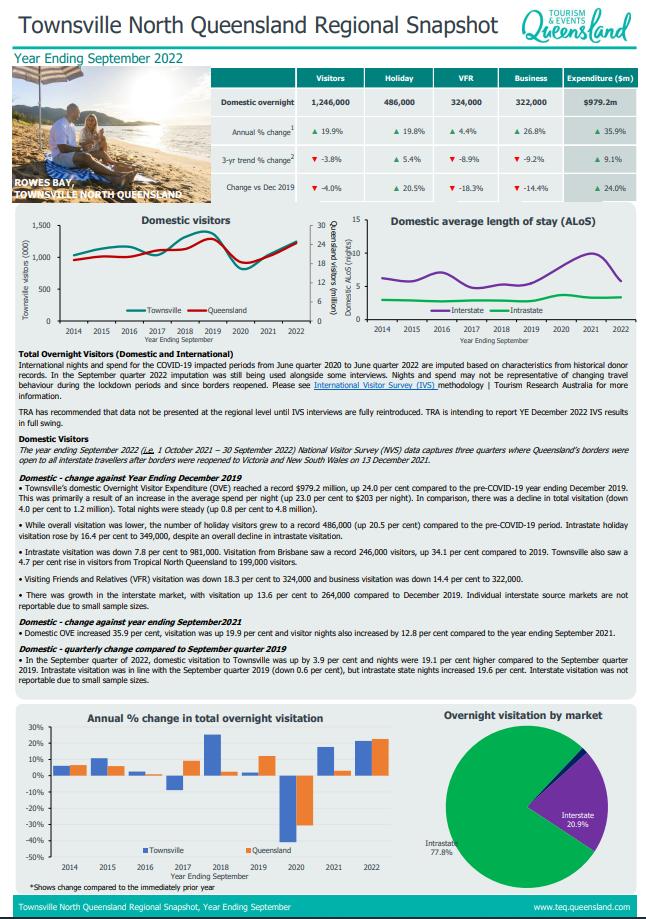
Magnetic Island (Yunbenun) Tourism Masterplan - 2023 55

Magnetic Island (Yunbenun) Tourism Masterplan - 2023 56

Magnetic Island (Yunbenun) Tourism Masterplan - 2023 57
Appendix 2 – Infrastructure
Waste
All waste collected on Magnetic Island is taken to the waste transfer station in Picnic Bay, owned and operated by TCC. It is loaded into skips, crushed, compacted, and transported to the mainland. Kerbside General waste collections occur weekly, and co-mingled recycling collections occur biweekly. Transport of waste and recycling off-island occurs three to five times a week via a barge to Townsville for landfill or processing. TCC is considering potential organic management solutions to reduce household waste. Facilities are available at the waste transfer station to separate recyclables such as scrap metal, co-mingled recycling, motor oil, and batteries. A ‘tip shop’ is also operated by TCC at the waste transfer station to salvage saleable items and further reduce waste transport off the island.
There are no RV dump points for tourists in motorhomes which acts to limit stay duration and can lead to illegal disposal of sewage. However, visitors to the island can access public place waste and recycling bins as well as the waste transfer station. Beaches on Magnetic Island are often contaminated with plastic waste washed up as debris. The community organises annual beach clean-up days. TCC is working on the island to introduce circular systems with waste management and water reduction.
Wastewater infrastructure and treatment
Two wastewater treatment plants in Picnic Bay and Horseshoe Bay are treating most of the island’s effluent. In addition, some residents have individual septic systems (46%). TCC is also looking for additional areas to discharge treated water for irrigation in the Picnic Bay catchment and is investigating alternative effluent discharge options. The wastewater treatment plant at Horseshoe Bay is around 50% of its design capacity, whereas the plant at Picnic Bay is close to its design capacity. New development on the island and back-sewering are likely to require additional effluent discharge capacity and duplication of the sewerage treatment plant at Picnic Bay. Alternative effluent discharge options and an increase in plant capacity will require negotiation with the state government environmental regulator. Investors have indicated that wastewater infrastructure is a significant
constraint for development. TCC is open to investigating options to expand sewage treatment capacity on the island.
Energy
Magnetic Island sources electricity from the mainland grid operated by Ergon Energy. Energy issues around reduction and efficiency are well understood by Magnetic Island residents due to the long history of energy efficiency projects onisland. There is a strong solar energy culture on the island as well as a high concentration of solar infrastructure throughout the community due to the successful Solar City Program in 2007.
Magnetic Island is supplied with electricity by Ergon Energy via two submarine cables extending from the mainland to Nelly Bay. One of the cables is nearing its end of life and is mark for an upgrade. Upgrades will need consider potential population growth and peak season loads for tourism. Ergon are interested in investigating alternative solutions to the upgrade or the delay of the submarine cable.
Water
Magnetic Island is dependent on Townsville for its water supply. Potable water is supplied through a high-density polyethylene submarine pipeline that extends for 5.6km from Pallarenda on the Mainland to Bolger Bay reservoir¹⁸. From the reservoir, water is distributed to other reservoirs on the island and finally delivered to the island’s properties. Rainwater tanks are installed at some residences (18%).
Per capita water consumption on Magnetic Island is almost three times higher than the state average. Tourism also contributes to higher water consumption. Townsville City Council installed 1,616 smart water meters in November 2020 to help reduce water consumption and cut ongoing costs. This covers almost all homes and businesses on the island. 19
The community expressed an interest in becoming more self-sufficient in access to potable water and less reliant on mainland supply. 20 Water saving measures are important for residents and tourists to understand and implement. This could potentially be linked to the tourism sector on the island.
Magnetic Island (Yunbenun) Tourism Masterplan - 2023 58
19 Magnetic Island Decarbonisation of Great Barrier Reef Islands –Whole of Community Pilot Project EarthCheck et al 2021.
–
20 Magnetic Island Decarbonisation of Great Barrier Reef Islands
Whole of Community Pilot Project EarthCheck et al 2021.
Medical services
The island does not have its own hospital and the nearest is located in Townsville. In the case of emergency, helicopter transport can be used, with the helipad located in Nelly Bay. Three medical centres and an ambulance operate on Magnetic Island running a 24-hour service. This presents difficulties during peak times as minimal staff are available for 24-hour servicing.
Crisis and Emergency Response: There is a disaster management plan for the Townsville Region which includes actions for Magnetic Island and delegated authority TCC, however there is no stand-alone evacuation or disaster management plan for the island. There is no designated cyclone shelter on the island.
Resilience
Climate change brings new risks and opportunities for Magnetic Island. It will be critical to build the capability at a local level to assess and manage heatwaves, bushfires, storms and coastal erosion and inundation, and reduced economic losses due to transport disruption from extreme weather events.
Water supply, natural disasters, power generation and the island’s reliance on the mainland for food, water, energy and medical services are seen as areas of significant concern. Both residents and businesses reported increasing insurance expenses are their biggest climate related impact. The Magnetic Community recognises this and wants to work towards a future where they are less dependent on the mainland for these essential goods and services. Future planning needs to centre on adapting and protecting public and private infrastructure and services and making them more climate resilient. Targeted support will be required to assist the tourism industry to adapt, withstand and recover from climate change impacts, while continuing to operate and serve the community and visitors to Magnetic Island.
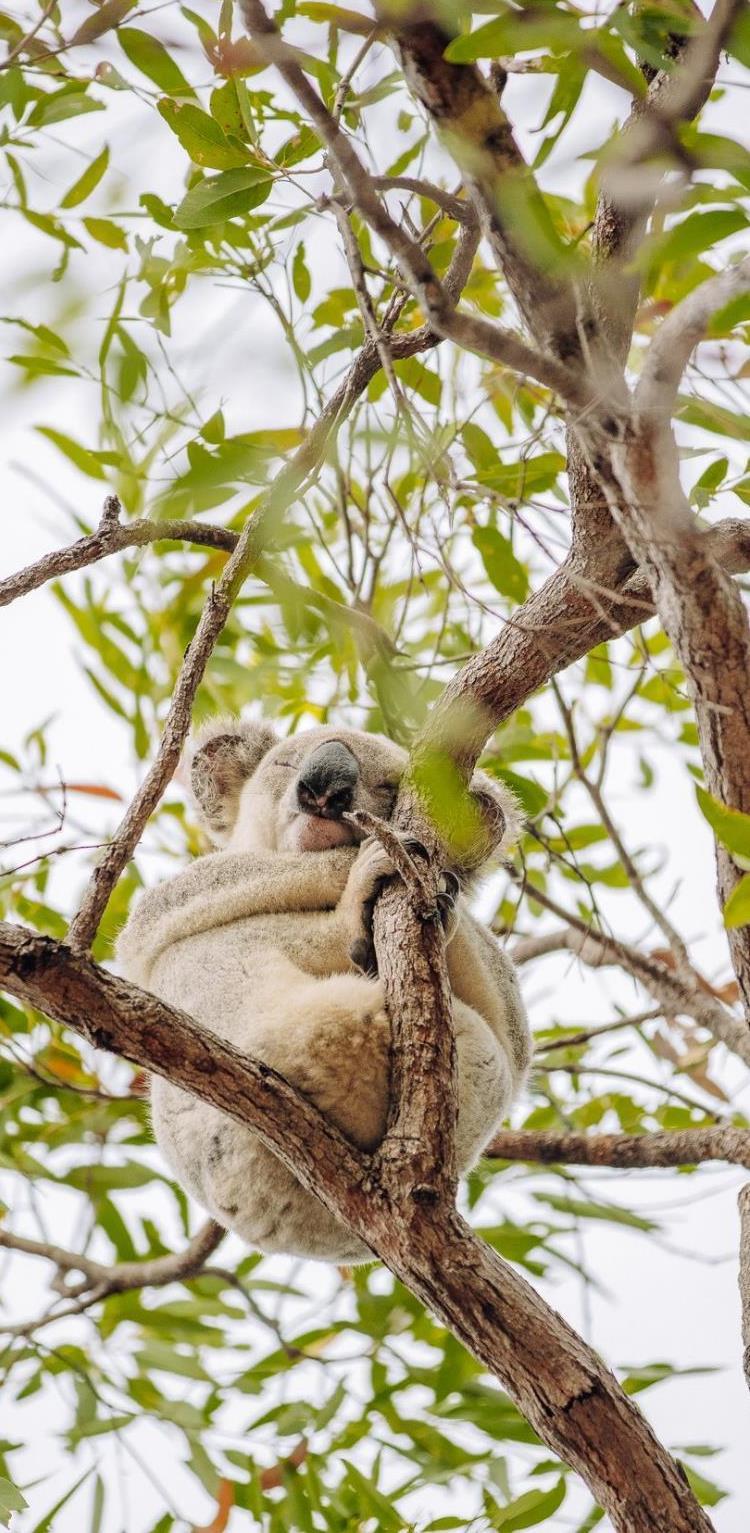
Magnetic Island (Yunbenun) Tourism Masterplan - 2023 59
Appendix 3 – Magnetic Island Visitors and New Attractions – Economic modelling
This section covers: projections of visitors over a 10-year period based on continuation of current trends; an estimate of additional growth with the introduction of new experiences and facilities; an analysis of the proposed experiences and potential use/participation; and an assessment of future room requirements based on the two growth scenarios. The assumptions used in the modelling are outlined.
Magnetic Island Visitors
Data for 2019 from 2 sources indicate that visitor numbers were 290,500 in 2019 (pre -covid). Passenger data from Sealink, MI Ferries, Breakwater Marina and Townsville Yacht Club combined indicate around 290,500 visitors. Similarly the Magnetic Island Economic AnalysisSeptember 2019, AEC (prepared for Townsville Enterprise Limited) has similar estimates of around 290,000 visitors. In the analysis, it is assumed that visitor numbers were static until 2022, given some travel disruptions due to Covid in 2020 and 2021
Scenario 1: Trend Growth Rate
The following are projections for visitors to Magnetic Island over a 10 year period from Year 1 (2022) and assume an annual growth rate of 2.2% per year.21
Based on this growth rate, total visitors increase by 64,232 over the 10 years from 2022 (from 296,891 visitors to 361,123). The increase on 2019 visitor levels is around 76,600.
These projections are conservative and designed to indicate the potential future visitor numbers in the absence of the introduction of the new experiences and facilities.
Scenario 2: Growth with New Experiences & Facilities
The analysis in section 2 shows the number of visitors likely to use the facilities and programs. This comprises persons that would visit anyway; and those that would decide to visit because of the programs and facilities.
To model the impact of new experiences and facilities improvement, we have assumed it adds one percentage point to the annual growth rate over 10 years (i.e. an increase from 2.2% to 3.2%). Based on this growth rate, total visitors increase by 98,259 over the 10 years from 2022 (from 299,796 to visitors to 398,055). The increase on 2019 visitors is around 107,560. This growth aligns with our modelling and estimates in section 2 of the additional visitors attracted due to the new facilities and experiences. In the analysis we have identified: persons that would visit anyway; and those that would decide to visit because of the programs and facilities.
21 2.2% is the average growth rate between 20192022 for holiday visitors to Townsville Region.
Source: Townsville Regional Snapshot, Year Ending
Magnetic Island (Yunbenun) Tourism Masterplan - 2023 60
March 2019 & Townsville Regional Snapshot, Year Ending March 2022, Tourism & Events Queensland.
Table 8. Projected Visitors to Magnetic Island– Growth Scenarios
Source: MCa modelling & analysis, September 2022

Magnetic Island (Yunbenun) Tourism Masterplan - 2023
Magnetic Island Visitors Estim ates Y1 Y2 Y3 Y4 Y5 Y6 Y7 Y8 Y9 Y10 Increase 10 years Increas e on 2019 2019 202 0 202 1 202 2 202 3 202 4 2025 202 6 202 7 202 8 202 9 203 0 203 1 Scenario 1: Current Trends Projections: Ave growth 2.2% pa Scenario 1: 2.2% Growth Visitors (no.) 290,5 00 290, 500 290, 500 296, 891 303, 423 310, 098 316,9 20 323, 892 331, 018 338, 300 345, 743 353, 349 361, 123 64,23 2 70,6 23 Scenario 2: New Experiences & Facilities Projections: Ave growth 3.2% pa Scenario 2: 3.2% Growth Visitors (no.) 290,5 00 290, 500 290, 500 299, 796 309, 389 319, 290 329,5 07 340, 051 350, 933 362, 163 373, 752 385, 712 398, 055 98,25 9 107, 555
Magnetic Island (Yunbenun) Tourism Masterplan - 2023 62
Figure 7. Visitor Growth Scenarios - Trend growth rate and facilitated growth rate – 10 years
Source: MCa modelling & analysis, September 2022
Figure 8. Magnetic Island Scenarios - Increase in Visitors
MCa modelling
analysis,
2022 Increase 10 Years Increase on 2019 Scenario 1: Current Trends 64,232 70,623 Scenario 2: New Experiences 98,259 107,555 64,232 70,623 98,259 107,55520,000 40,000 60,000 80,000 100,000 120,000 Base 2019 2022 2023 2024 2025 2026 2027 2028 2029 2030 2031 Scenario 1: Current Trends 290,500 296,891 303,423 310,098 316,920 323,892 331,018 338,300 345,743 353,349 361,123 Scenario 2: New Experiences 290,500 299,796 309,389 319,290 329,507 340,051 350,933 362,163 373,752 385,712 398,055 323,892 361,123 340,051 398,055 280,000 300,000 320,000 340,000 360,000 380,000 400,000 420,000
Source:
&
September
Magnetic Island Accommodation
Estimates were made of the accommodation (rooms) required to service visitor number in the two growth scenarios. Current visitor accommodation was estimated at 720: 600 rooms in hotel, resort, and hostels; and 40 Airbnb properties with estimated 120 rooms (average 3 bedrooms).22 The modelling is based on the assumptions outlined in the table below.
The modelling indicates that additional rooms would be required to service the visitor growth under both scenarios. The table and chart show the gap between rooms requirements and the current room stock. For Scenario 1 an additional 148 room would be required and 236 for Scenario 2.
Magnetic Island (Yunbenun) Tourism Masterplan - 2023 63
Accommodation Modelling Assumptions Visitor Mix 75% overnight & stay in paid accommodation 25% day visitors or stay with friends or family (VFR) Average stay 3 nights Room Use 70% twin share; 30% single use Source: MCa modelling & analysis, September 2022
Future
- Estimates Magnetic Island Room Requirements Y1 Y2 Y3 Y4 Y5 Y6 Y7 Y8 Y9 Y10 Increase 10 years 2022 2023 2024 2025 2026 2027 2028 2029 2030 2031 Scenario 1: Current Trends (2.2% Growth) Room Requirements 714 729 746 762 779 796 813 831 849 868 148 Current Rooms 720 720 720 720 720 720 720 720 720 720 Additional Rooms Needed - 9 26 42 59 76 93 111 129 148 148 Scenario 2: New Experiences & Facilities (3.2% Growth) Room Requirements 721 744 768 792 818 844 871 899 927 957 236 Current Rooms 720 720 720 720 720 720 720 720 720 720 Additional Rooms Needed 1 24 48 72 98 124 151 179 207 237 236 Source: MCa modelling & analysis, September 2022
Table 9. Accommodation Assumptions
Table 10.
Room Requirements
22 Number on Airbnb website on September 22, 2022
Magnetic Island (Yunbenun) Tourism Masterplan - 2023 64
Source: MCa modelling & analysis, September 2022 Y1 Y2 Y3 Y4 Y5 Y6 Y7 Y8 Y9 Y10 Scenario 1: Current Trends 0 9 26 42 59 76 93 111 129 148 Scenario 2 : New Experiences & Facilities 0 24 48 72 98 124 151 179 207 236 0 24 48 72 98 124 151 179 207 236 0 50 100 150 200 250
Figure 9. Additional Rooms Required to Service Visitors (estimates)
Appendix 4 – Consultation Summary
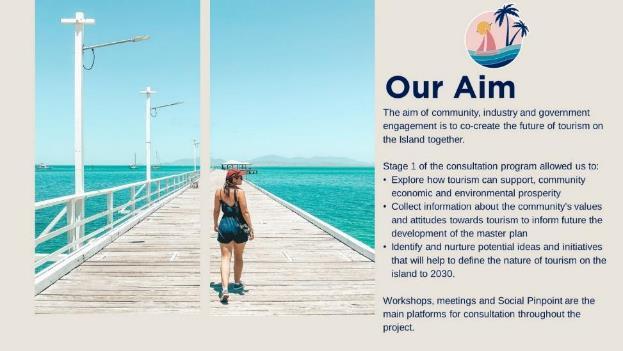
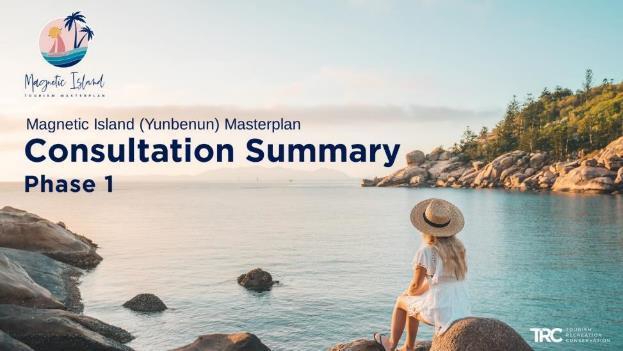
Magnetic Island (Yunbenun) Tourism Masterplan - 2023 65
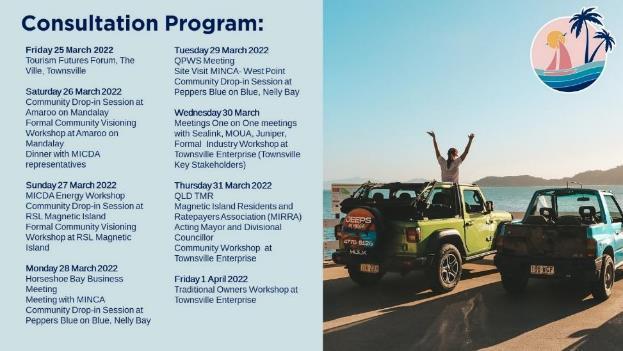
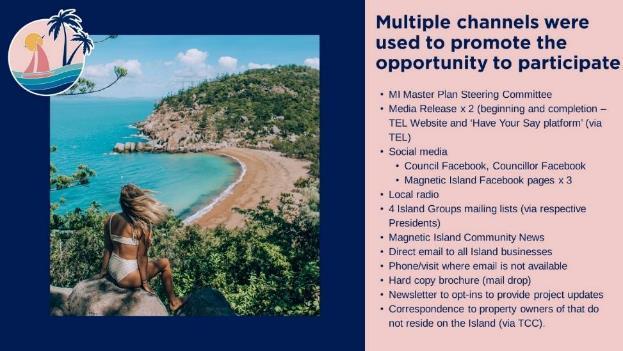
Magnetic Island (Yunbenun) Tourism Masterplan - 2023 66


Magnetic Island (Yunbenun) Tourism Masterplan - 2023 67

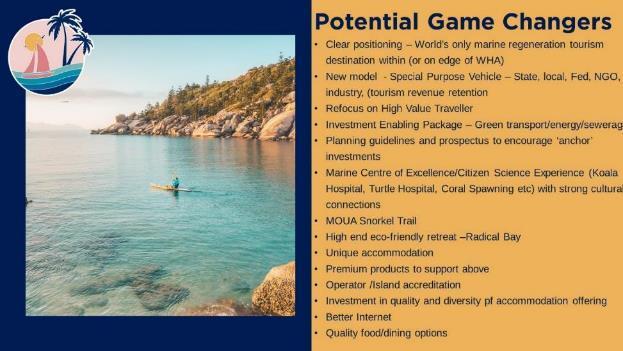
Magnetic Island (Yunbenun) Tourism Masterplan - 2023 68

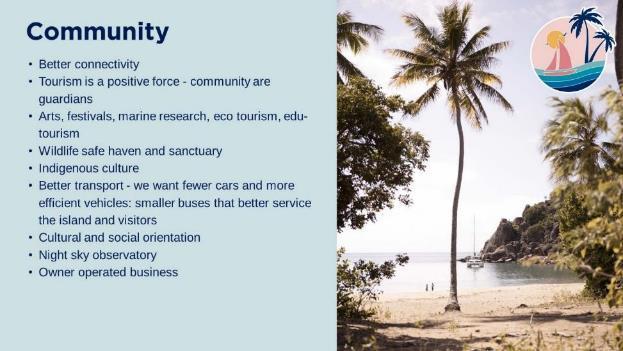
Magnetic Island (Yunbenun) Tourism Masterplan - 2023 69
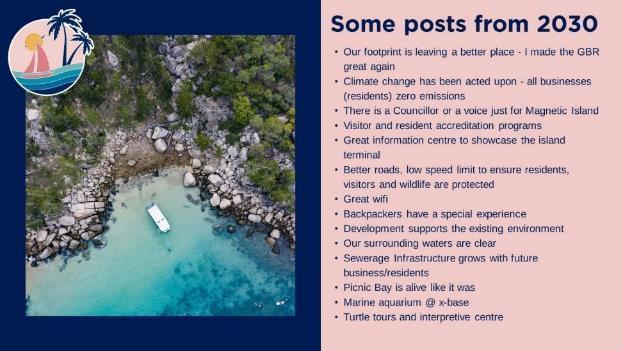

Magnetic Island (Yunbenun) Tourism Masterplan - 2023 70

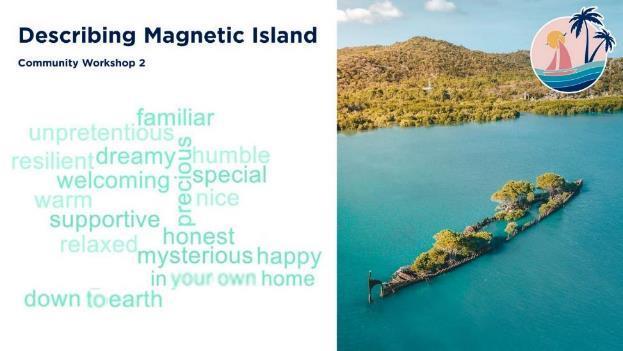
Magnetic Island (Yunbenun) Tourism Masterplan - 2023 71
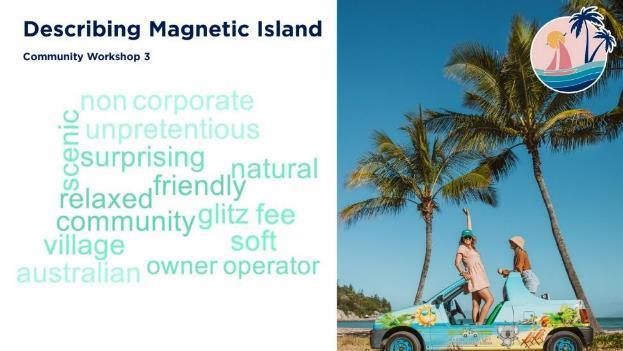
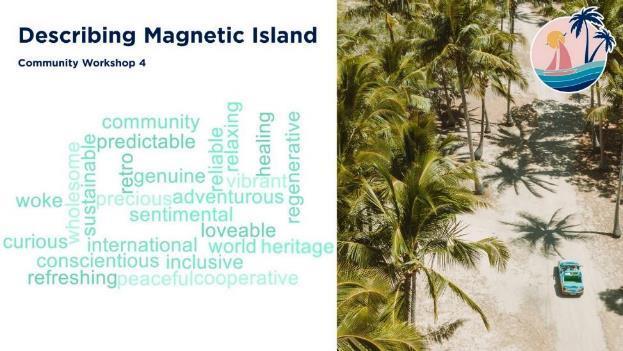
Magnetic Island (Yunbenun) Tourism Masterplan - 2023 72
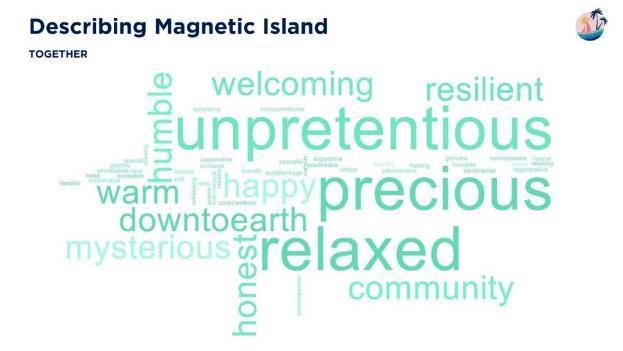
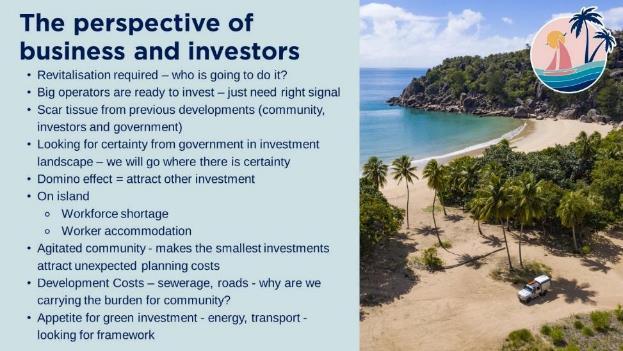
Magnetic Island (Yunbenun) Tourism Masterplan - 2023 73

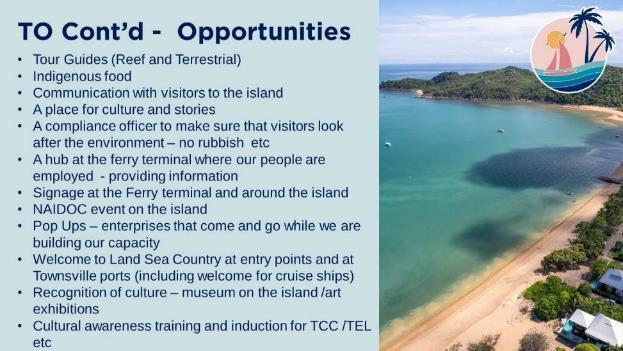
Magnetic Island (Yunbenun) Tourism Masterplan - 2023 74
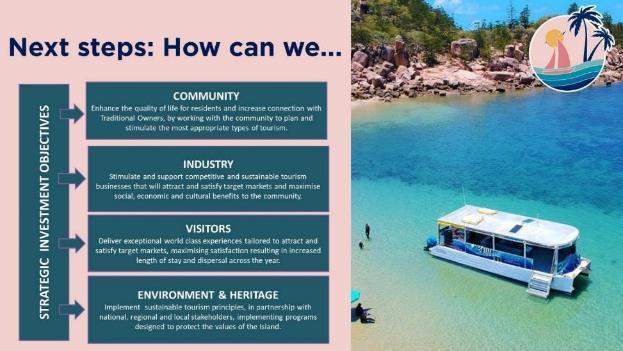

Magnetic Island (Yunbenun) Tourism Masterplan - 2023 75
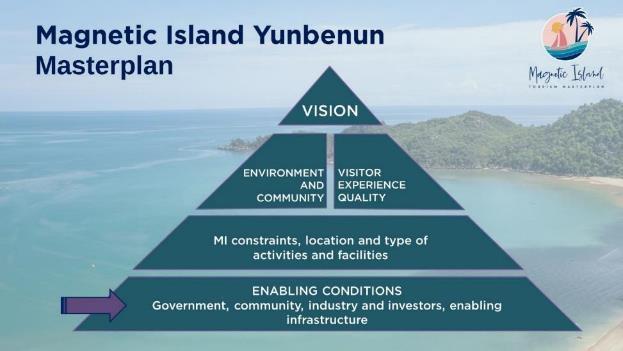

Magnetic Island (Yunbenun) Tourism Masterplan - 2023 76
Disclaimer
This report is for the use only of the party to whom it is addressed and for the specific purposes to which it refers. We disclaim any responsibility to any third party acting upon or using the whole or part of the report and its contents.
This report (including appendices) is based on estimates, assumptions and information sourced and referenced by MCa < Michael Connell & Assocs.>. These estimates, assumptions and projections are provided as a basis for the reader’s interpretation and analysis. In the case of projections, they are not presented as results that will actually be achieved.
The report has been prepared on the basis of information available at the time of writing. While all possible care has been taken by the authors in preparing the report, no responsibility can be undertaken for errors or inaccuracies that may be in the data used.
Magnetic Island (Yunbenun) Tourism Masterplan - 2023 77


































































































